Contents
ABSTRACT
This study aimed to evaluate the relationship between perceived uncertainty and purchase intention through bibliometric analysis. The method used was a bibliometric analysis, assessing relevant literature from the Scopus database between 2002 and 2024. Data was collected using the keywords perceived uncertainty and purchase intention, and analyzed with Biblioshiny and Vos Viewer software. This research is novel as it is the first bibliometric study conducted on this relationship. The main findings include: first, an annual growth rate of 11.57% in publications, indicating increasing academic interest, with an average of 20.13 citations per document. Second, source analysis revealed that key literature came from psychology, marketing, information systems, and economics, with journals like Frontiers in Psychology having significant influence. Third, the terms perceived uncertainty and purchase intention have been the focal points of recent research. Fourth, scholarly mapping showed a strong international collaboration network, with the US, China, and the UK playing dominant roles. Fifth, terms like consumer trust and purchase intention appeared with higher density, suggesting their central role in related research, while variables like “brand loyalty” and “perceived value” appeared with lower density. Sixth, the Uncertainty Reduction Theory dominated with 11 publications. This research offered valuable insights for academics and opens opportunities for further research on contextual factors influencing this relationship. The practical relevance of this study including businesses can use AI to manage consumer uncertainty, enhance trust, and improve purchase intentions, emphasizing uncertainty management’s role in shaping behavior and driving competitive advantages.
INTRODUCTION
Perceived uncertainty plays a vital role in shaping consumer purchase intentions across different product categories and contexts. Several studies have investigated the intricate relationship between uncertainty and purchase intentions, explaining how it influences consumer behavior. Study by Al-Thaqeb SA, et al.,[1] focused on the impact of uncertain rewards on impulse purchase intentions of blind box products, highlighting how perceived uncertainty can drive impulse purchase behavior. This study underscores the importance of understanding how uncertainty influences consumers’ decision-making processes, especially in the context of novelty and surprise associated with blind box products.
Next, Aria M, et al.,[2] emphasized the role of perceived uncertainty in online communities, suggesting that higher levels of uncertainty can act as a barrier to purchase intentions, especially for consumers who are highly engaged in the product. This opinion suggests that reducing uncertainty should be an essential strategy for sellers looking to increase purchase intentions among consumers with varying levels of product involvement. Similarly, Armawan, et al.,[3] explored consumer uncertainty from a multidimensional perspective, highlighting how different dimensions of uncertainty interact with antecedents and consequences, such as information-seeking intentions and purchase intentions. This nuanced approach provides insight into the complex nature of consumer uncertainty and its impact on purchase decisions. Furthermore, Armawan, et al.,[4] explored the interaction between consumer uncertainty, country-of-origin image, and brand image on purchase intention, particularly in the context of high-tech products from China. This study reveals the negative influence of country-of-origin image on purchase intention, which is mediated by consumer uncertainty. In addition, Bevan LD.[5] highlighted the effect of perceived uncertainty on intention to purchase organic vegetables, suggesting that higher levels of perceived uncertainty can dampen purchase intentions.
In addition, a study by Bulsara HP, et al.,[6] emphasized the mediating role of consumer trust and price sensitivity in influencing purchase intentions, especially in situations where consumer trust in retailers is low. Uncertainty and doubts about product quality can significantly affect purchase intentions, highlighting the importance of building trust and reducing uncertainty to drive consumer purchase decisions. In addition, Byé MF, et al.,[7] explored the impact of an individual’s level of uncertainty avoidance on the relationship between risk and purchase intention in Hungarian e-commerce.
In essence, the synthesis of these studies underscored the complex relationship between uncertainty and purchase intentions. Perceived uncertainty can act as a significant barrier to purchase intentions, influencing consumers’ decision-making processes across different product categories and contexts. Understanding and managing perceived uncertainty is critical for businesses looking to increase purchase intentions and drive consumer behavior effectively.
Subsequently, several researchers have conducted literature reviews and have reported on the various frameworks that have been used during the period, their results and future research directions on perceived uncertainty[8–16] or purchase intention.[17–25] However, we have not found any literature review on perceived uncertainty related to purchase intention. To the best of the authors’ knowledge, this study is the first bibliometric analysis of the relationship between perceived uncertainty and purchase intention.
This study uniquely contributed to bibliometric research by addressing a gap in understanding the bibliometric trends of perceived uncertainty and purchase intention. While previous studies have explored the impact of uncertainty on consumer behavior, this is the first bibliometric analysis examining the intellectual structure, thematic evolution, and influential research in this domain. By mapping the academic landscape, this study provided insights into emerging research themes, highlights influential scholars and institutions, and identifies key theoretical frameworks that shape the discourse on perceived uncertainty and purchase intention.
The purpose of this research article is to evaluate the relationship between purchase intention, address the limitations of previous studies, and present to scholars and practitioners contemporary and comprehensive research developments surrounding the relationship between perceived uncertainty and purchase intention. Bibliometric analysis techniques were used, and our research presents information about:
Descriptive and Trend Analysis (Annual; Average Citation per year).
Source Analysis (Most Relevant Sources; Source Impact; Bradfords Law).
Document Analysis (Top Global Cited Paper; Word Cloud; Trending Topic).
Author Analysis (Top Contributor; Authors Productivity; Authors Impact; Country-wise Analysis).
Conceptual Structure (Co-occurrence Network; Thematic Map; Thematic Evolution).
Intellectual Structure (Co-Citation Network).
Social Structure (Country collaboration map).
LITERATURE REVIEW
Perceive Uncertainty
Future environmental conditions that were unpredictable due to knowledge asymmetry were referred to as uncertain.[26] When it comes to business, perceived uncertainty is the degree to which retailer- and product-related factors make it impossible to predict with certainty how a transaction will turn out.[27] Customers naturally want to know what suppliers are doing, but merchants are not always dependable, which leads to perceived uncertainty. Retailer quality uncertainty and product quality uncertainty were the two categories of perceived uncertainty. Retailers act like sellers, concealing their genuine nature, making exaggerated claims, or deceiving customers, which are examples of retailer quality doubt. Furthermore, product quality uncertainty pertains to the actual product quality.[28,3]
Conceptualized consumer uncertainty as a multidimensional construct, encompassing product uncertainty, environmental uncertainty, and psychological uncertainty. While this approach offered a comprehensive lens, its applicability in e-commerce remains underexplored. In online environments, uncertainty arises from limited tactile engagement, fluctuating information quality, and dynamic pricing strategies. Extending Shiu et al., model to e-commerce, future studies should examine how real-time consumer feedback mechanisms, algorithmic personalization, and brand transparency can mitigate uncertainty and enhance purchase intention.
Prior studies have demonstrated that a significant deterrent to online shopping for consumers was uncertainty. Previous research has examined uncertainty in a number of contexts, including online advertising,[28] supply chain,[29] and e-government.[30]
Purchase Intention
Purchase intention, which represents the likelihood of an individual customer to purchase, is an essential indicator of the customer’s future consumption behavior.[31] Consumer purchasing behavior and non-purchase behavior were heavily influenced by trust.[32]
Purchase intention is decision-making that studies consumers’ reasons for buying a particular brand.[33,34] described purchase intention as a scenario in which customers are inclined to purchase a specific product under certain circumstances. Making purchases as a customer is a complex procedure. The actions, attitudes, and perceptions of the customer often influence purchase intentions.
Purchasing behavior was a pivotal point for consumers to access and evaluate certain products.[35] claimed that one helpful method for forecasting the purchasing process is purchase intention. Price, as well as perceived quality and value, could have an impact on purchase intentions. Furthermore, during the purchasing process, buyers were impacted by both internal and external incentives.[36] Researchers have recommended six phases to consider before making a purchase: awareness, knowledge, interest, preference, persuasion, and purchase.[37,38] Consumers usually believe that buying inexpensive, poorly branded items with plain packaging carries a significant risk since they can never be sure of the product’s quality.[39]
METHODOLOGY
Research Design
This research used the bibliometric analysis method, which was helpful in analyzing publication production and scientific research trends in various research fields. It classified metadata obtained from the indexer journal database and interpreted the results obtained.[40]
Bibliometric analysis was a valuable method for evaluating scientific literature and understanding research trends. Using a variety of techniques and tools, researchers could gain insight into the structure and dynamics of knowledge domains.[41] Identified influential articles[42] and assessed research performance.[40]
Bibliometric indicators could also highlight the most cited articles, influential authors, and leading institutions in a given field, providing insight into the main contributors to scientific knowledge.[43] The bibliometric analysis could be integrated with the statistical R-package (Biblioshiny), where the program Could analyze developments and be helpful in a changing field.[44]
Based on Figure 1 which illustrates the comprehensive procedure for obtaining data., the data selection process was conducted systematically as follows:
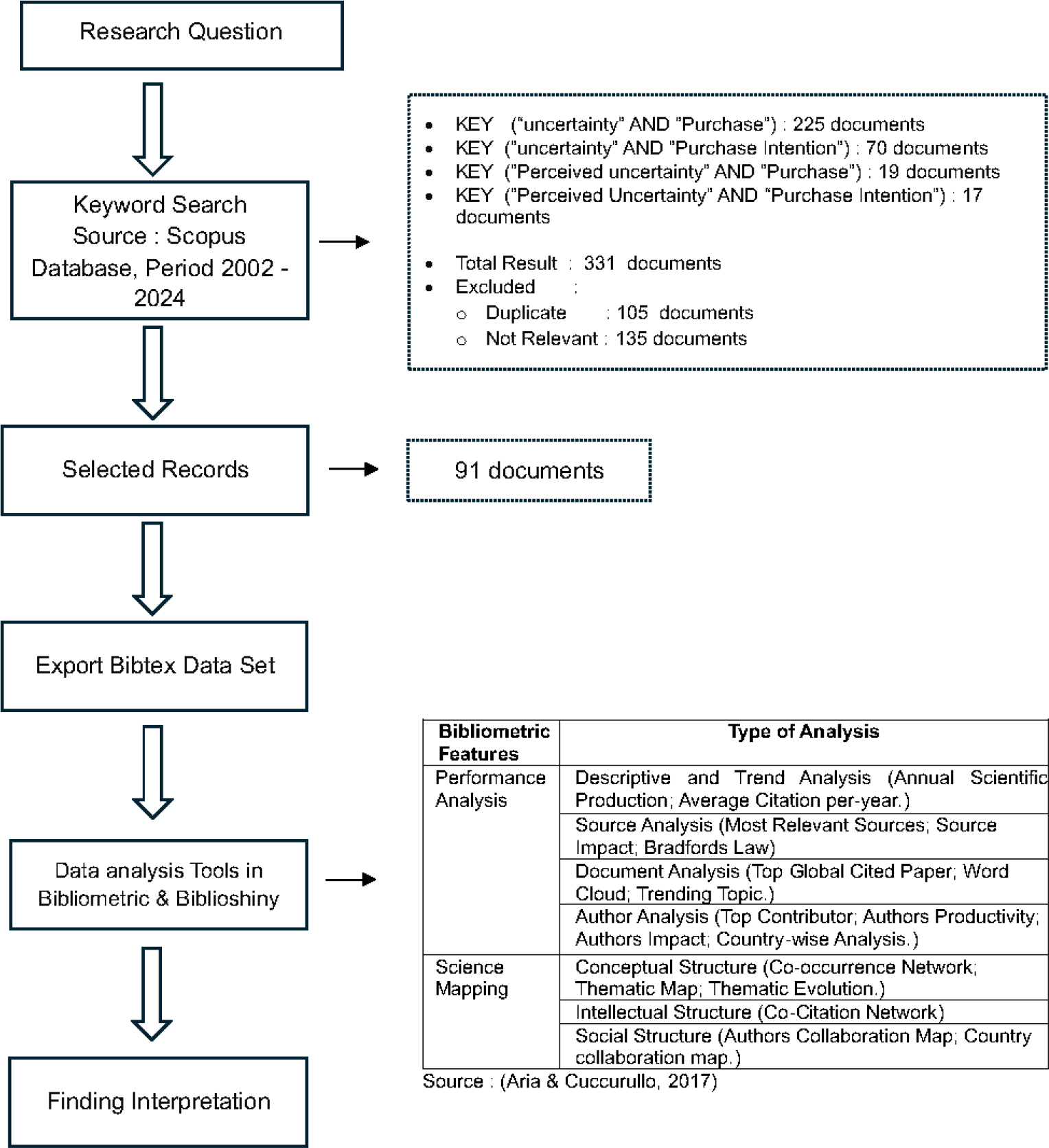
Figure 1:
Diagram Flow Bibliometric Analysis.
First, the research question was established to guide the study. The keyword search was then performed using the Scopus database, covering publications from 2002 to 2024. The selection of this timeframe aligns with the significant rise in digital commerce and shifting consumer behaviors influenced by technological advancements.
The search utilized four keyword combinations: (“uncertainty” AND “purchase”), (“uncertainty” AND “purchase intention”), (“perceived uncertainty” AND “purchase”), and (“perceived uncertainty” AND “purchase intention”), yielding a total of 331 documents.
Next, a filtering process was applied to refine the dataset. A total of 105 documents were excluded due to duplication, while 135 documents were deemed irrelevant. After this screening, 91 relevant documents were selected for further analysis.
The extracted metadata was downloaded in BibTeX format and RIS format then imported into Biblioshiny (BibtTeX format) and VosViewer (RIS format) for analysis. Initial preprocessing involved deduplication, normalization of author names, and keyword harmonization to ensure consistency. Co-occurrence analysis was conducted to identify emerging themes, while co-citation analysis mapped intellectual influences within the field. This structured approach ensured the reliability and validity of the bibliometric findings.
The data was then processed using bibliometric tools such as Biblioshiny and VosViewer. These tools facilitated performance analysis, including descriptive trend analysis, source impact assessment, document and author analysis, and country-wise contributions. Additionally, science mapping techniques, such as co-occurrence networks, thematic evolution, and collaboration mapping, were applied.
Finally, the analyzed data was interpreted to derive meaningful insights regarding the relationship between perceived uncertainty and purchase intention in academic literature.
Data sources and types
This study’s data collection process involved searching the Scopus database article titles for articles published between 2002 and 2024 with the keywords perceived uncertainty and Purchase Intention. Scopus was chosen over other databases like Web of Science due to its extensive coverage of business, marketing, and consumer behavior literature. Scopus indexes a diverse range of high-impact journals and conference proceedings, ensuring a comprehensive dataset for bibliometric analysis. Additionally, Scopus provides robust citation tracking features that enable the identification of influential works and scholarly networks, thereby offering a more detailed understanding of the intellectual landscape in this research domain.
The document obtained was a raw file with a bib extension, which was then processed and analyzed using Biblioshiny, which is part of the R and R-Studio programs.
Biblioshiny and VosViewer were selected due to their specialized capabilities in bibliometric visualization and network analysis. Biblioshiny, an R-based software, facilitates trend analysis, co-citation mapping, and thematic evolution tracking, allowing for a nuanced understanding of research developments. VosViewer, on the other hand, excels in network clustering and density visualization, making it instrumental in identifying core research themes and collaboration patterns. The combination of these tools ensures a rigorous and comprehensive bibliometric assessment.
The data collection process utilizes several stages presented in flow charts and flowcharts that visually represent the study selection process. These charts show the number of records identified, included, and excluded, along with the reasons for exclusion.[45]
Data Analysis
Data analysis in this study consists of biblioshiny processing in the form of diagrams and graphs, which researchers then analyze and describe into easy-to-understand sentences. Bibliometric analysis is carried out according to the suggestions of Aria and Cuccurullo, 2017 which are divided into 2 groups of analysis, namely Performance Analysis (Descriptive and Trend Analysis, Source Analysis, Document Analysis, and Author Analysis) and Science Mapping (Conceptual Structure, Intellectual Structure, Social Structure, and Vos Viewer Analysis).
RESULTS AND DISCUSSION
Performance Analysis
The performance analysis revealed some essential information about the literature data related to perceived uncertainty and purchase intention collected between 2002 and 2024 (Table 1).
| Description | Results | Description | Results |
|---|---|---|---|
| Main Information About Data | Authors of single-authored docs | 6 | |
| Timespan | 2005:2024 | Authors Collaboration | |
| Sources (Journals, Books, etc.) | 49 | Single-authored docs | 6 |
| Documents | 91 | Co-Authors per Doc | 2.99 |
| Annual Growth Rate % | 11.57 | International co-authorships % | 25.27 |
| Document Average Age | 4.8 | Document Types | |
| Average citations per doc | 20.13 | article | 83 |
| References | 0 | book chapter | 4 |
| Document Contents | conference paper | 4 | |
| Keywords Plus (ID) | 292 | ||
| Author’s Keywords (DE) | 265 | ||
| Authors | |||
| Authors | 166 | ||
| Authors of single-authored docs | 6 |
In the period from 2002 to 2024, there were a total of 49 sources, such as journals and books, that produced 91 article documents on the relationship between perceived uncertainty and purchase intention. The annual growth rate of documents reached 11.57%, with the average age of documents being 4.8 years. Each document had an average of 20.13 citations, although no references were recorded. In terms of document content, there were 292 keywords from Keywords plus (ID) and 265 keywords from authors (DE). There were a total of 166 authors involved, with only 6 authors having self-authored documents. For author collaboration, there were 6 documents
Source Analysis
Most Relevant Sources
Source analysis showed that the 20 most relevant sources on the relationship between perceived uncertainty and purchase intention came from various conferences and scientific journals (Table 2).
| Sources | Number of Articles | Sources | Number of Articles |
|---|---|---|---|
| Frontiers In Psychology | 5 | Service Industries Journal | 3 |
| Developments In Marketing Science: Proceedings of the Academy of Marketing Science | 4 | Technological Forecasting and Social Change | 3 |
| Asian Journal of Business Research | 3 | 2016 13th International Conference on Service Systems and Service Management, Icsssm 2016 | 2 |
| International Business Review | 3 | Annals of Operations Research | 2 |
| International Journal of Environmental Research and Public Health | 3 | Applied Economics | 2 |
| Journal Of Marketing Management | 3 | Asia Pacific Journal of Marketing and Logistics | 2 |
| Journal of Product and Brand Management | 3 | International Journal of Emerging Markets | 2 |
| Journal of Services Marketing | 3 | Journal of Asia Business Studies | 2 |
| Management Science | 3 | Journal of Distribution Science | 2 |
| Przestrzen Spoleczna | 3 | Journal of Global Sport Management | 2 |
Frontiers in Psychology emerged as the most relevant source with the highest number of articles 5, This suggests that the journal is a crucial platform for research related to perceived uncertainty and purchase intentions. Developments In Marketing Science: Proceedings of The Academy of Marketing Science followed with 4 articles, confirming the critical role of academic conferences and proceedings in disseminating the latest research in this field.
Other journals, such as the Asian Journal of Business Research, International Business Review, International Journal of Environmental Research and Public Health, Journal of Marketing Management, Journal of Product and Brand Management, Journal of Services Marketing, Management Science, and Przestrzen Spoleczna, had 3 articles each This shows that these journals are also very relevant and are often used as references in this study.
Journals such as Service Industries Journal and Technological Forecasting and Social Change were also noted as essential sources. Three articles each in the Asian Journal of Business Research and International Business Review reflect the importance of business and environmental research in this study.
In addition, conferences such as the 2016 13th International Conference on Service Systems and Service Management also played an essential role with 2 articles, indicating that these conferences are critical platforms for researchers to share the latest findings. Other journals such as Annals of Operations Research, Applied Economics, Asia Pacific Journal of Marketing and Logistics, International Journal of Emerging Markets, Journal of Asia Business Studies, Journal of Distribution Science, and Journal of Global Sport Management had 2 articles each, emphasizing their contribution in spreading knowledge and research related to this topic.
This diversity of sources reflects the breadth of fields of study involved in analyzing the relationship between perceived uncertainty and purchase intention, including psychology, marketing, human behavior, information systems, and engineering economics. This diversity shows that research on the relationship between perceived uncertainty and purchase intention covers a wide range of interconnected disciplines, providing a comprehensive view of the topic being analyzed.
Source Impact
The results of the source impact analysis show several vital metrics that illustrate the influence and relevance of various journals and conferences on the topic of the relationship between perceived uncertainty and purchase intention (Table 3).
| Source | h_Index | g_Index | m_Index | Total Citation | Number of Publication | Publication Year Start |
|---|---|---|---|---|---|---|
| Frontiers in Psychology | 5 | 5 | 1.67 | 76 | 5 | 2022 |
| International Business Review | 3 | 3 | 0.33 | 66 | 3 | 2016 |
| International Journal of Environmental Research and Public Health | 3 | 3 | 0.50 | 19 | 3 | 2019 |
| Journal of Marketing Management | 3 | 3 | 0.75 | 99 | 3 | 2021 |
| Journal of Product and Brand Management | 3 | 3 | 0.21 | 75 | 3 | 2011 |
| Journal of Services Marketing | 3 | 3 | 1.50 | 33 | 3 | 2023 |
| Management Science | 3 | 3 | 0.21 | 181 | 3 | 2011 |
| Service Industries Journal | 3 | 3 | 0.60 | 513 | 3 | 2020 |
| Annals of Operations Research | 2 | 2 | 0.10 | 7 | 2 | 2005 |
| Applied Economics | 2 | 2 | 0.17 | 16 | 2 | 2013 |
| Asia Pacific Journal of Marketing and Logistics | 2 | 2 | 0.20 | 82 | 2 | 2015 |
| International Journal of Emerging Markets | 2 | 2 | 1.00 | 70 | 2 | 2023 |
| Journal of Asia Business Studies | 2 | 2 | 0.67 | 10 | 2 | 2022 |
| Journal of Distribution Science | 2 | 2 | 0.33 | 24 | 2 | 2019 |
| Journal of Marketing Channels | 2 | 2 | 0.29 | 6 | 2 | 2018 |
| Journal of Promotion Management | 2 | 2 | 0.25 | 8 | 2 | 2017 |
| Journal of Retailing and Consumer Services | 2 | 2 | 1.00 | 46 | 2 | 2023 |
| Journal of Travel and Tourism Marketing | 2 | 2 | 0.29 | 50 | 2 | 2018 |
| Omega (United Kingdom) | 2 | 2 | 0.17 | 28 | 2 | 2013 |
| Technological Forecasting and Social Change | 2 | 2 | 1.00 | 7 | 3 | 2023 |
Journals like Frontiers in Psychology have an h-index and g-index of 5 each, with 76 citations from 5 publications since 2022. These findings show that the journal is a significant platform for researchers to publish influential work in a relatively short time. With a high m-index of 1.67, International Business Review also has a significant influence, with an h-index and g-index of 3 and 66 citations from 3 publications since 2016.
Furthermore, the International Journal of Environmental Research and Public Health shows relevance with an h-index and g-index of 3, with 19 citations from 3 publications since 2019, showing a steady contribution to environmental health research and its impact on consumer behavior. The Journal of Marketing Management recorded 99 citations from 3 publications since 2021, showing it to be an essential resource in marketing management with an h-index and g-index of 3 and an m-index of 0.75.
Next is the Journal of Product and Brand Management and Management Science, with 75 and 181 total citations, respectively, albeit with a lower m-index of 0.21, showing consistent contributions since 2011. Service Industries Journal has had a significant impact, with 513 citations from 3 publications since 2020, emphasizing the importance of research in the service industry.
Other journals, such as the Journal of Services Marketing, Annals of Operations Research, Applied Economics, and Asia Pacific Journal of Marketing and Logistics, show variations in h-index, g-index, and total citations, reflecting significant contributions in their specialized fields. Journal of Services Marketing has a high m-index of 1.50, indicating high productivity in the short time since 2023. Furthermore, the International Journal of Emerging Markets and the Journal of Retailing and Consumer Services show increasing relevance and influence, with an h-index and g-index of 2 and a high m-index of 1.00, respectively. Technological Forecasting and Social Change also show high productivity with an m-index of 1.00 out of 3 publications since 2023, albeit with lower total citations.
This analysis shows that even though some sources have the same number of articles, their impact, and relevance can be very different depending on the number of citations and other metrics. The journals Computers in Human Behavior and Frontiers in Psychology are examples of sources that have a high citation impact. In contrast, some conferences and other journals have a lower impact despite having been published for several years.
Bradfords Law
The results of the source analysis based on Bradford’s Law show a frequency distribution of publications that conforms to Bradford’s principle, which divides sources into zones based on relevance and number of publications (Figure 2). In this analysis, two zones were identified. Zone 1 consists of journals with the highest frequency of articles, such as Frontiers in Psychology with 5 articles, followed by Developments in Marketing Science: Proceedings of the Academy of Marketing Science with 4 articles In addition, journals such as Asian Journal of Business Research, International Business Review, International Journal of Environmental Research and Public Health, Journal of Marketing Management, Journal of Product and Brand Management, Journal of Services Marketing, Management Science, and Przestrzen Spoleczna contributed 3 articles each Overall, Zone 1 includes a total of 10 journals with a cumulative article frequency of 33.
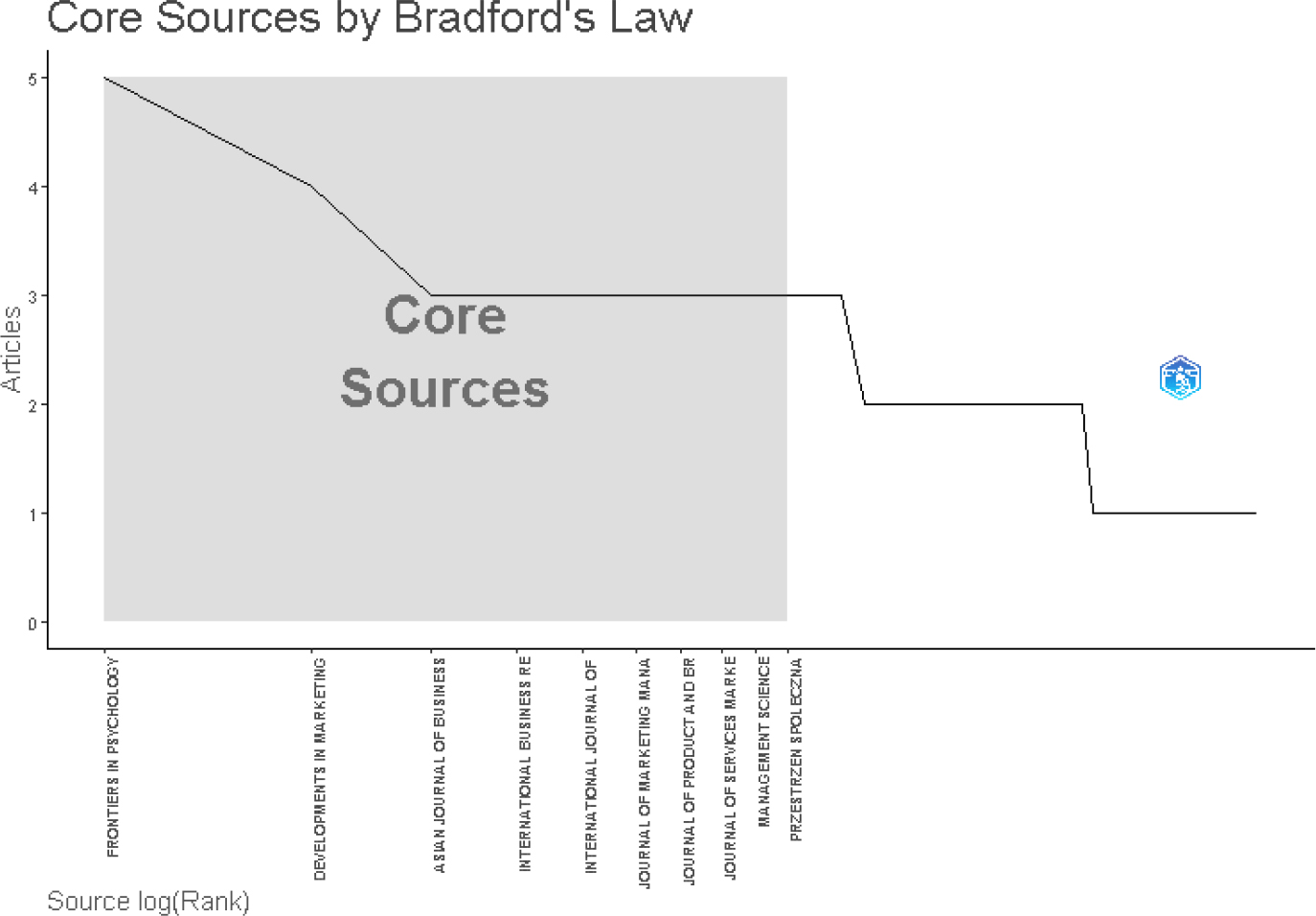
Figure 2:
Core Sources By Bradford’s Law.
Zone 2 consists of journals with a slightly lower frequency of articles. For example, Service Industries Journal and Technological Forecasting and Social Change had 3 articles each. At the same time, conferences such as the 2016 13th International Conference on Service Systems and Service Management, ICSSSM 2016, and journals such as Annals of Operations Research, Applied Economics, Asia Pacific Journal of Marketing and Logistics, International Journal of Emerging Markets, Journal of Asia Business Studies, Journal of Distribution Science, and Journal of Global Sport Management contributed 2 articles each Zone 2 also includes a total of 10 journals with a cumulative article frequency of 22 This analysis shows that most of the relevant articles are distributed across a small number of journals in Zone 1, while the rest are spread across more journals with lower frequencies in Zone 2.
Document Analysis
Top Global Cited Paper
The top globally cited papers on perceived uncertainty and purchase intention include a variety of significant studies, which are presented in Table 4 below.
| Paper | DOI | Total Citation | Total Citation Per Year |
|---|---|---|---|
| Zhang M, 2020, Serv Ind J | 10.1080/02642069.2019.1576642 | 171 | 34.20 |
| Swinney R, 2011, Manage Sci | 10.1287/Mnsc.1110.1360 | 148 | 10.57 |
| Chung H, 2012, J Money Credit Bank | 10.1111/J.1538-4616.2011.00478.X | 130 | 10.00 |
| Nocke V, 2011, J Econ Theory | 10.1016/J.Jet.2010.07.008 | 74 | 5.29 |
| Hill Rv, 2012, Exp Econ | 10.1007/S10683-011-9303-7 | 61 | 4.69 |
| Jia S, 2018, J Real Estate Financ Econ | 10.1007/S11146-017-9615-2 | 43 | 6.14 |
| Kaur G, 2015, Asia Pac J Mark Logist | 10.1108/Apjml-10-2014-0146 | 41 | 4.10 |
| Islam T, 2023, Int J Emerg Mark | 10.1108/Ijoem-08-2021-1194 | 35 | 17.50 |
| Souiden N, 2011, J Prod Brand Manage | 10.1108/10610421111157883 | 35 | 2.50 |
| ISLAM T, 2023, INT J EMERG MARK-A | 10.1108/IJOEM-08-2021-1194 | 35 | 17.50 |
| Wu X, 2021, J Mark Manage | 10.1080/0267257x.2021.1910328 | 33 | 8.25 |
| Lim S, 2013, Omega | 10.1016/J.Omega.2012.12.003 | 26 | 2.17 |
| Yu Tw, 2018, J Travel Tour Mark | 10.1080/10548408.2018.1486781 | 25 | 3.57 |
| Chen Y, 2015, Manage Sci | 10.1287/Mnsc.2014.2004 | 24 | 2.40 |
| Chen X, 2023, J Retail Consum Serv | 10.1016/J.Jretconser.2023.103441 | 23 | 11.50 |
| Hasegawa Rb, 2019, Epidemiology | 10.1097/Ede.0000000000000989 | 23 | 3.83 |
| Zeng H, 2016, Int Bus Rev | 10.1016/J.Ibusrev.2016.01.007 | 22 | 2.44 |
| Zhu Dh, 2015, Internet Res | 10.1108/Intr-12-2013-0257 | 22 | 2.20 |
| Zeng H, 2016, Int Bus Rev | 10.1016/J.Ibusrev.2016.01.007 | 22 | 2.44 |
| Simpson B, 2008, Soc Netw | 10.1016/J.Socnet.2007.04.004 | 19 | 1.12 |
Articles were identified based on their high number of citations, demonstrating their influence and relevance in this area of research. The paper by Zhang M., published in 2020 in Serv Ind J, had a total of 171 citations with an average of 34.20 citations per year, indicating a significant impact in a relatively short time. Another highly cited paper was by Swinney M., published in 2011 in Manage Sci with a total of 148 citations and an average of 10.57 citations per year. Research by Chung H. in 2012 in J Money Credit Bank also stands out with a total of 130 citations and an average of 10.00 citations per year.
In addition, the work of Nocke V in 2011 in J Econ Theory has a total of 74 citations, with an average of 5.29 citations per year. Furthermore, Research by Hill Rv in 2012, Exp Econ also received significant attention with 61 citations, as well as an average of 4.69 citations per year. These articles, along with the others listed in the table, show the importance of the topic of perceived uncertainty in influencing purchase intention and make a significant contribution to the scientific literature. These studies help us understand how uncertainty can influence consumer decisions.
Table 4, which lists the top globally cited papers, underscored the foundational research shaping this field. Highly cited papers have contributed to theoretical advancements, such as the integration of Uncertainty Reduction Theory with digital trust frameworks, and have introduced novel empirical methodologies, including neuro-marketing techniques to assess consumer responses to uncertainty. These contributions not only define the academic trajectory but also influence business strategies in managing consumer perceptions of risk.
Word Cloud
This word cloud provides a concise visual representation of the key concepts and potential relationships explored in studies on perceived uncertainty and purchase intention. It helps researchers quickly identify key themes and understand the focus of research on this relationship.
From Figure 3, the most prominent words, such as purchase intention, uncertainty, perceived uncertainty, and uncertainty avoidance, indicate that these themes are the main focus in the analyzed literature. Other significant terms include e-commerce, product uncertainty, and cross-border e-commerce. The size of each word in the word cloud indicates its frequency or importance in the research context. More prominent words, such as purchase intention and uncertainty, indicate that these terms appear frequently and take center stage in the studies analyzed. This theme suggests that many studies have explored how perceived uncertainty affects consumer purchase intention. Other terms, such as live streaming e-commerce and trust, indicate that the online shopping context is an important area where the relationship between perceived uncertainty and purchase intention is explored.
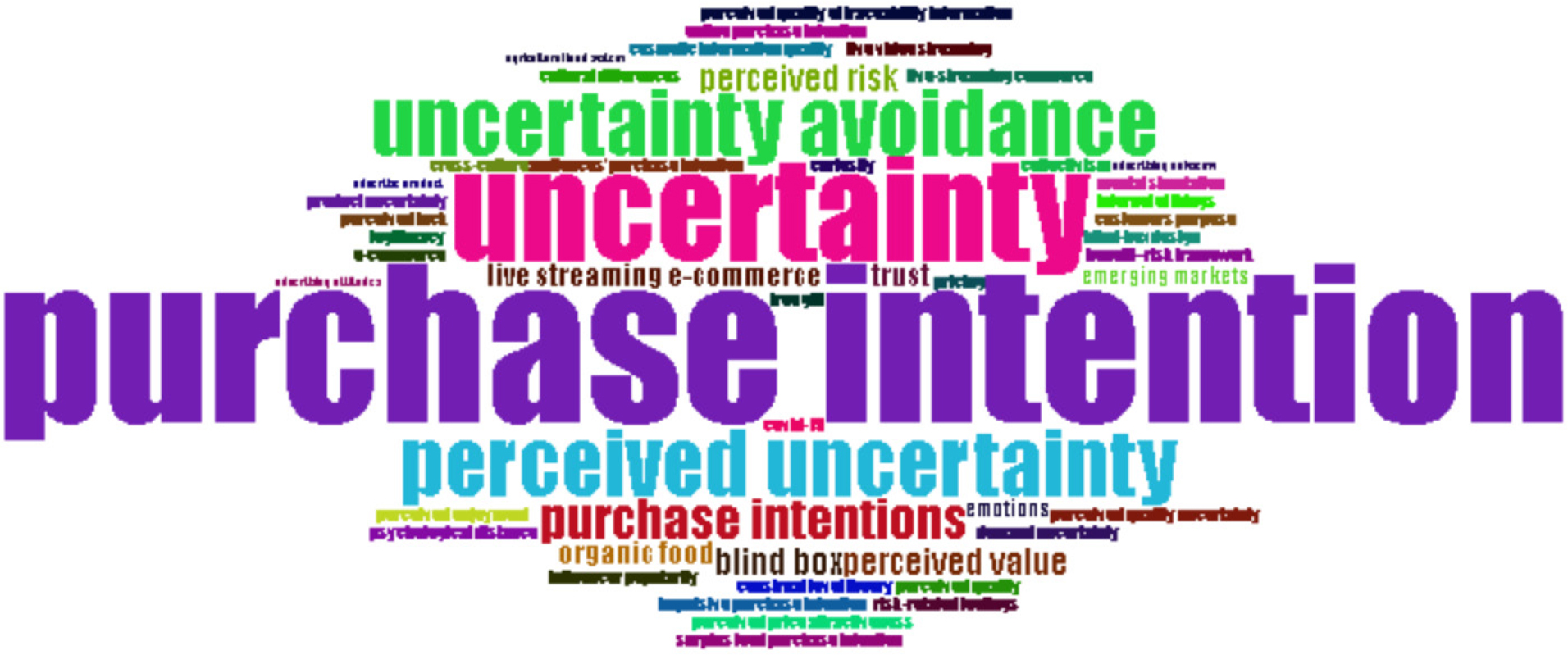
Figure 3:
Word Cloud.
Trending Topic
Trending topics in research addressing the relationship between perceived uncertainty and purchase intention show a number of essential themes that have evolved (Figure 4). Topics such as uncertainty avoidance began to appear as early as 2017, suggesting that interest in uncertainty-reducing behaviors dates back more than a decade. Meanwhile, purchase intention and trust were in high demand in early 2018, with relatively consistent emergence in subsequent years. Furthermore, topics such as perceived value, perceived risk, and organic food showed increased attention in the 2019-2021 period.
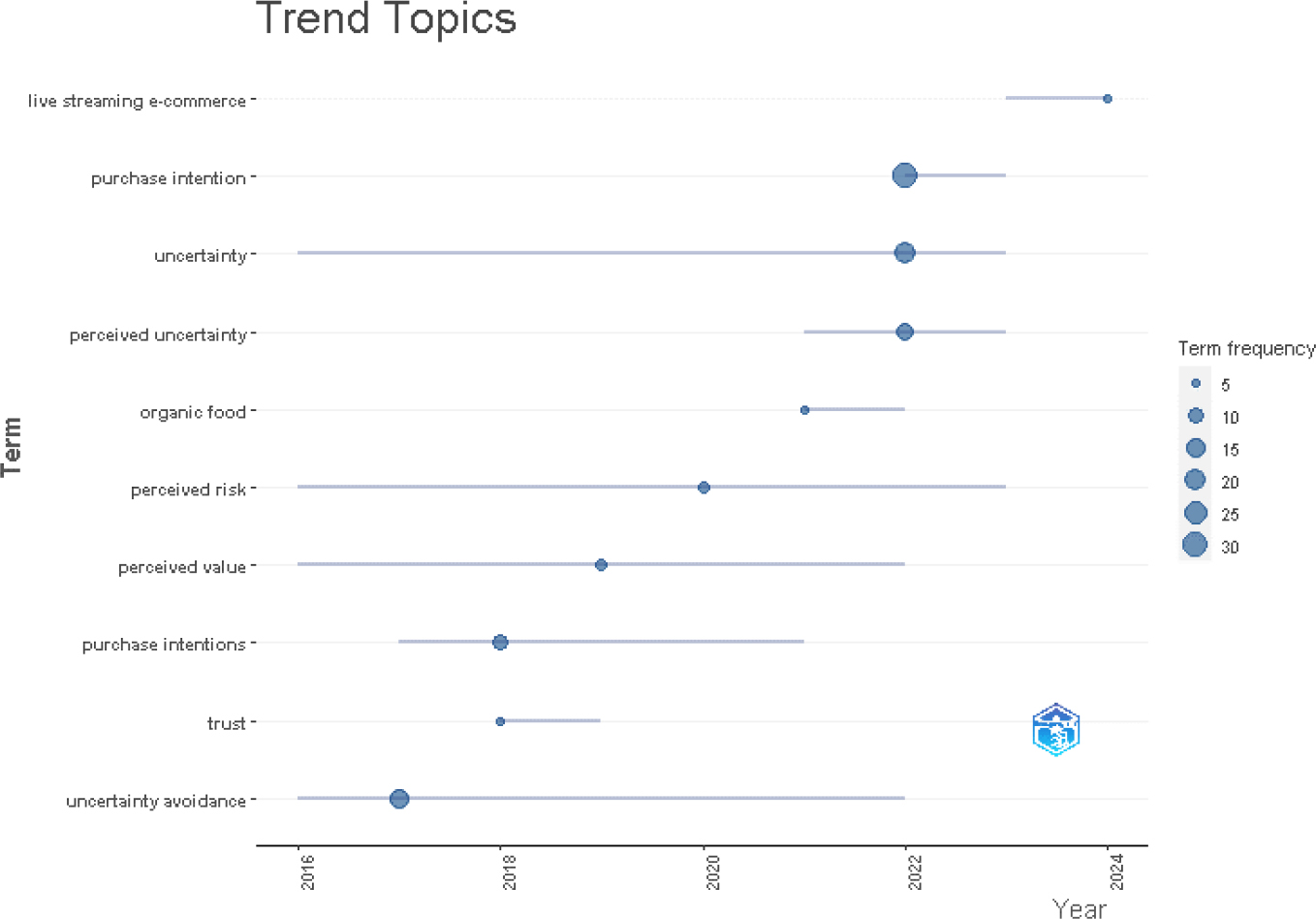
Figure 4:
Trending Topic.
The topics of perceived uncertainty, uncertainty, and purchase intention have shown increasing interest in recent years, especially from 2021 to 2023. Perceived uncertainty and e-commerce are also being discussed more frequently, with live-streaming e-commerce showing continued relevance until 2024.
Author Analysis
Top Contributor
In the study of the relationship between perceived uncertainty and purchase intention, a number of researchers contributed significantly. The data in Table 5 shows some of the leading researchers along with the number of articles they published and the number of articles that were fractionalized, i.e., the division of author contributions in multi-author articles. Table 6 shows that research on perceived uncertainty and purchase intention is a dynamic field with contributions from many leading researchers, who focus not only on the number of publications but also on collaboration and measurable contributions in each article they write.
| Authors | Articles | Articles Fractionalized | Authors | Articles | Articles Fractionalized |
|---|---|---|---|---|---|
| Zhang Y | 6 | 2.67 | Nagy | 3 | 0.75 |
| Chen Y | 4 | 0.93 | Ngo Dm | 3 | 0.75 |
| Wang Y | 4 | 1.08 | Ngo Tm | 3 | 0.75 |
| Wei S | 4 | 1.17 | Qin F | 3 | 0.75 |
| Zhang T | 4 | 2.00 | Rahman Aba | 3 | 0.43 |
| Ali Na | 3 | 0.43 | Sidek Sb | 3 | 0.43 |
| Chen C | 3 | 1.50 | Tang H | 3 | 0.43 |
| Hao L | 3 | 1.50 | Thi Vap | 3 | 0.75 |
| Hu J | 3 | 0.43 | Wang Ga | 3 | 0.75 |
| Luo C | 3 | 0.75 | Wen S | 3 | 0.43 |
| Element | h_index | g_index | m_index | Total Citation | Number of Publication | Publication Year Start |
|---|---|---|---|---|---|---|
| Wang Y | 4 | 4 | 0.5714 | 142 | 4 | 2018 |
| Wei S | 4 | 4 | 1.3333 | 80 | 4 | 2022 |
| Zhang T | 4 | 4 | 0.4000 | 66 | 4 | 2015 |
| Zhang Y | 4 | 6 | 0.3077 | 52 | 6 | 2012 |
| Chen C | 3 | 3 | 1.5000 | 33 | 3 | 2023 |
| Hao L | 3 | 3 | 0.3333 | 66 | 3 | 2016 |
| Luo C | 3 | 3 | 0.6000 | 50 | 3 | 2020 |
| Qin F | 3 | 3 | 0.6000 | 46 | 3 | 2020 |
| Wang Ga | 3 | 3 | 0.6000 | 24 | 3 | 2020 |
| Wu X | 3 | 3 | 0.7500 | 16 | 3 | 2021 |
| Xiong J | 3 | 3 | 0.7500 | 6 | 3 | 2021 |
| Yan J | 3 | 3 | 0.7500 | 70 | 3 | 2021 |
| Zeng H | 3 | 3 | 0.3333 | 70 | 3 | 2016 |
| Zhang D | 3 | 3 | 1.5000 | 24 | 3 | 2023 |
| Zhang M | 3 | 3 | 0.6000 | 82 | 3 | 2020 |
| Arora A | 2 | 2 | 0.2500 | 82 | 2 | 2017 |
| Chen Tj | 2 | 2 | 0.2857 | 6 | 2 | 2018 |
| Chen X | 2 | 2 | 1.0000 | 6 | 2 | 2023 |
| Chung J | 2 | 2 | 0.3333 | 24 | 2 | 2019 |
Zhang Y is the highest contributing researcher, with 6 articles and 2.67 fractionalized articles. Chen Y followed this with 4 articles and 0.93 fractionalized articles, and Wang Y with 4 articles and 1.08 fractionalized articles. Other researchers who also have significant contributions include Wei S, with 4 articles (1.17 fractionalization articles), and Zhang T, who, despite having 4 articles, his fractionalization value reaches 2.00, indicating a significant contribution in each of his publications. Other researchers such as Ali Na, Chen C, Hao L, Hu J, Luo C, Nagy, Ngo Dm, Ngo Tm, Qin F, Rahman aba, Sidek Sb, Tang H, Thi Vap, Wang Ga, and Wen S also contributed significantly, with a total of 3 articles, and varying fractionalization values.
Authors Productivity
Based on the results of the Author’s Productivity analysis, some authors show varying productivity (Figure 5). Among the authors recorded in the study data, some of them showed considerable productivity as well as significant contributions in their fields. Zhang Y, for example, actively publishes research related to consumer behavior and uncertainty in the market. In 2024, he published several articles examining how gifts affect surplus food purchase intentions. In 2023, Zhang also explored the uncertainties in the platform market as well as optimal pricing strategies for new products.

Figure 5:
Authors’ Productivity.
Chen Y is another prolific author whose research focuses on reducing uncertainty in social e-commerce. In 2023, he published a study on reducing product uncertainty in live-streaming e-commerce, which showed a significant impact with 23 quotes. In 2022, Chen Y also researched the trust-building mechanism and its impact on purchase intent in social commerce. Wei, S., in line with Chen, also focuses on uncertainty in social trading. In 2024, Wei published research on the strict role of culture in managing user uncertainty in social e-commerce in Industrial Management and Data Systems. We also contributed to research on organic food consumption in China, exploring the role of perceived uncertainty.
Authors Impact
In the impact analysis of the authors of the article on the relationship between perceived uncertainty and purchase intent, some authors showed significant differences in their academic influence (Table 6).
Some authors point to significant differences in their academic influence. The author with the most significant influence in this field is Wang Y, who has an h-index and g-index of 4 each, as well as an m-index of 0.57 with a total of 142 citations and four publications since 2018, Wei S shows a strong and consistent contribution to related research.
On the other hand, Zhang T also has the same h-index and g-index of that size, but his m-index is lower, which is 0.40, with the same number of publications (4 publications since 2015), the growth rate of his influence is slightly slower than Wei S and Wang Y.
Chen C, with an h-index and a g-index of 3, has a total of 33 citations from 3 publications since 2023, showing a significant influence in a relatively short time. Meanwhile, Hao L, with an h-index and a g-index of 3, has a total of 66 citations from 3 publications since 2016, which shows a stable contribution but slower than Chen C in terms of increasing influence.
Other authors, such as Luo C, Qin F, and Wang Ga, also have the same h-index and g-index, which is 3. Luo C shows faster influence growth with the same m-index of 0.60 compared to Wu X, Xiong J, and Yan J, who have an m-index of 0.75 and have 3 publications since 2021. Authors such as Zeng H, Zhang D, and Zhang M all have an h-index of 3 but with significantly different citation totals. Zeng H has a total of 70 citations from 3 publications since 2016, showing a strong influence in his field. Meanwhile, Zhang D, with a total of 24 citations from 3 publications since 2023, also shows significant influence but in a shorter time than Zhang M.
Other authors with an h-index of 2, such as Arora A, Chen Tj, Chen X, and Chung J, have the same g-index and citation total. For example, Arora A, Chen Tj, and Chung J, despite having duplicate total citations (2), have a lower m-index than Chen X, suggesting that their contributions are more evenly distributed than those of other authors who may have a peak of citations in certain publications.
Most Cited Country Analysis
In the country-by-country analysis of the article on the relationship between perceived uncertainty and purchase intent, significant differences in the impact and contribution of different countries were seen (Table 7).
| Country | Total Citation | Average Article Citations | Country | Total Citation | Average Article Citations |
|---|---|---|---|---|---|
| China | 928 | 29 | Pakistan | 70 | 35 |
| USA | 409 | 27.3 | Lithuania | 15 | 15 |
| Korea | 95 | 19 | Spain | 9 | 2.2 |
| India | 92 | 23 | Japan | 6 | 3 |
| Germany | 74 | 74 | Hungary | 4 | 1 |
| Canada | 70 | 35 | Tanzania | 2 | 2 |
China emerged as the country with the highest total citations, reaching 928 with an average article citation of 29. This finding indicates that the country’s academic contribution is enormous and influential in the topics discussed. The USA also showed a significant influence, with a total of 409 citations and an average article citation of 27.30. This finding shows that despite the smaller number of articles, every article produced had a considerable impact.
Korea came in third place with a total of 95 citations and an average of 19 article citations, which also reflected a substantial contribution to related research. Next is India, with a total of 92 citations and an average citations of 23.
Furthermore, European countries such as Germany and Canada also show significant influence with a total of 74 and 70 citations, respectively, and the average citations of articles respectively, which are 74 for Germany and 35 for Canada, show that articles from these countries are highly valued in the academic community.
Other countries, such as Pakistan, Lithuania, Spain, and Japan, also made significant contributions, with high article citation averages of 70.15, 9, and 6, respectively. However, their citation totals were lower than those of the countries already mentioned.
Hungary and Tanzania, show a more limited contribution with lower total citations but fairly good article citation averages, suggesting that although the number of their publications could be better, the impact of each article produced is quite significant.
Scientific Mapping
Conceptual Structure
Co-occurrence Network
Figure 6 shows the results of the analysis of the co-occurrence network regarding the relationship between various concepts in the research literature. Key concepts such as purchase intention and uncertainty avoidance play an essential role in shaping relationships between various nodes. In contrast, some other concepts have a more limited role but remain relevant in specific contexts.
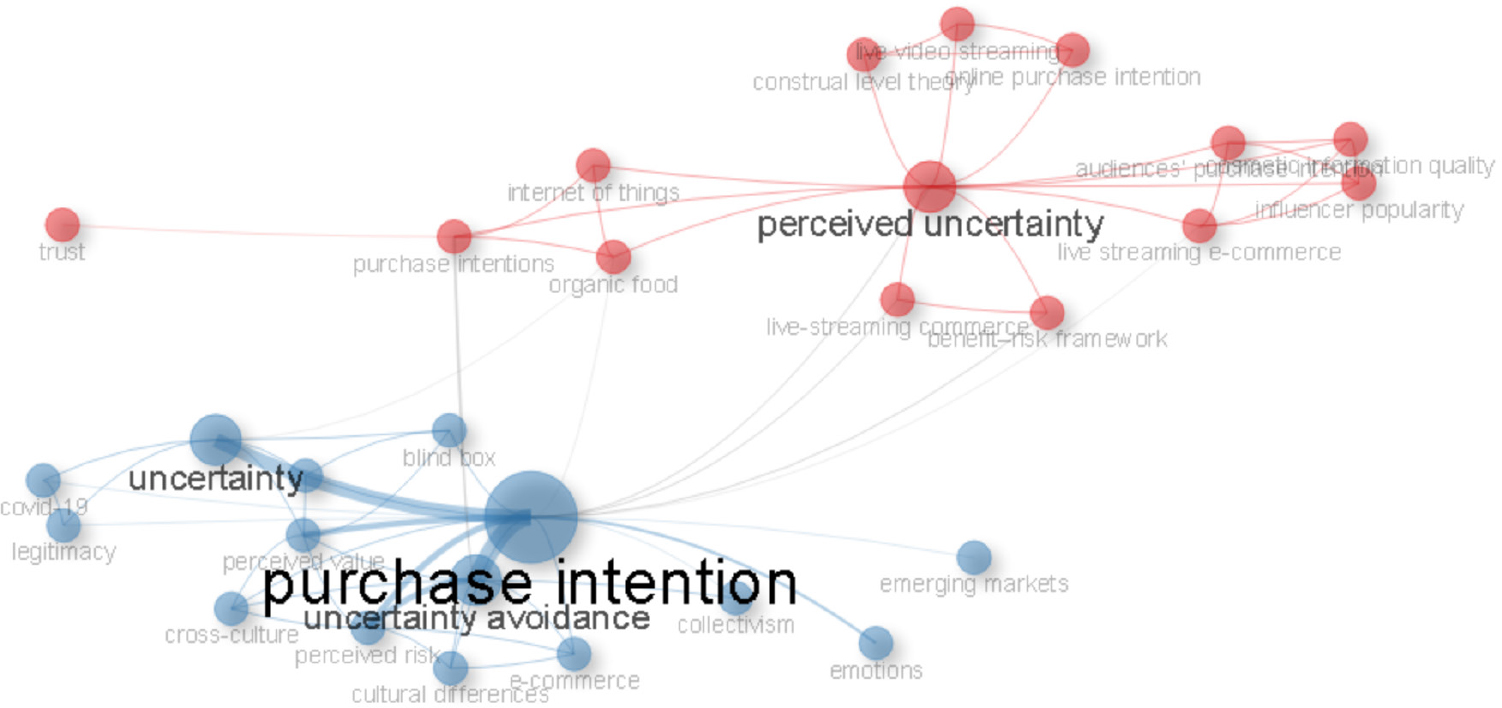
Figure 6:
Co-occurrence Network.
In this analysis, nodes with high betweenness values, such as perceived uncertainty, uncertainty, and uncertainty avoidance, show a central role in the network, indicating that they have a significant influence in connecting various other concepts. The purchase intent node, in particular, is in the limelight with a very high betweenness value and a high PageRank value, signaling its primary relevance in the context of this analysis.
Thematic Map
Figure 7 shows the distribution of research themes based on two axes: Relevance degree (Centrality) and Development degree (Density). The chart is divided into four quadrants: Niche Themes, Motor Themes, Emerging or Declining Themes, and Basic Themes.
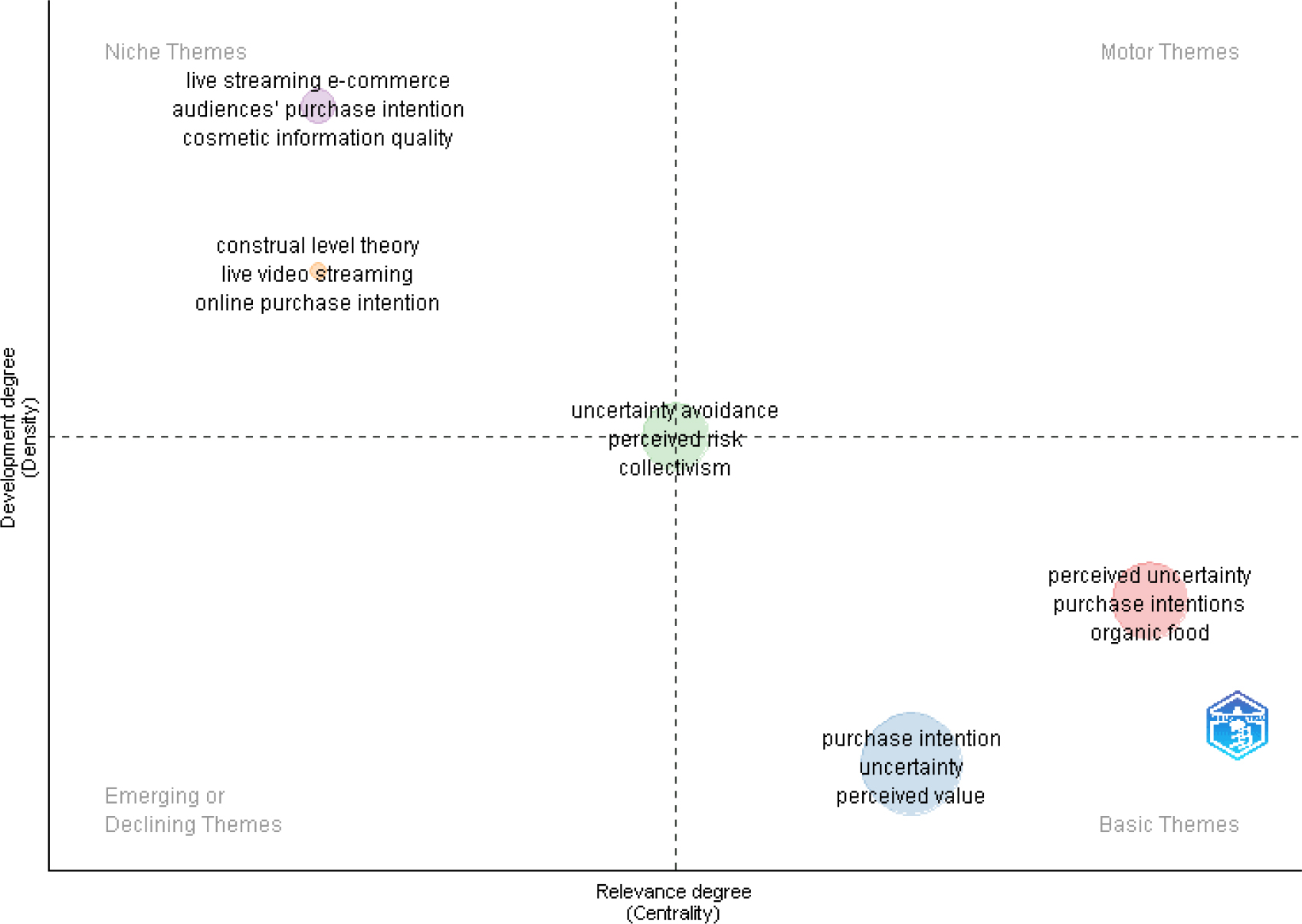
Figure 7:
Thematic Map.
In the Niche Themes quadrant, there are themes such as e-commerce live streaming, audience’s purchase intention, cosmetic information quality, construal level theory, live video streaming, and online purchase intention. These themes are specific and of high importance in certain contexts, but they are not yet widely used across research areas. In the Motor Themes quadrant, there are themes such as uncertainty avoidance, perceived risk, and collectivism related to credibility and social interaction. These themes are of great importance and have a significant influence on the development of research in the field, often being the main focus that drives further study progress.
In the quadrant of essential themes, fundamental concepts such as purchase intention, uncertainty, perceived value, perceived uncertainty, purchase intentions, and organic food are included, which are considered necessary. However, motor themes still need to be developed. Next, the emerging or declining themes quadrant shows topics that have emerged or lost their relevance over time. In this case, the themes in the emerging or declining themes quadrant are not mentioned for the study of the relationship between perceived uncertainty and purchase intention.
Thematic Evolution
The attached Biblioshiny thematic evolution graph shows (Figure 8) the development and relevance of research themes over time. The x-axis represents time divided into four periods: 2002-2015, 2016-2020, 2021-2022, and 2023-2024.
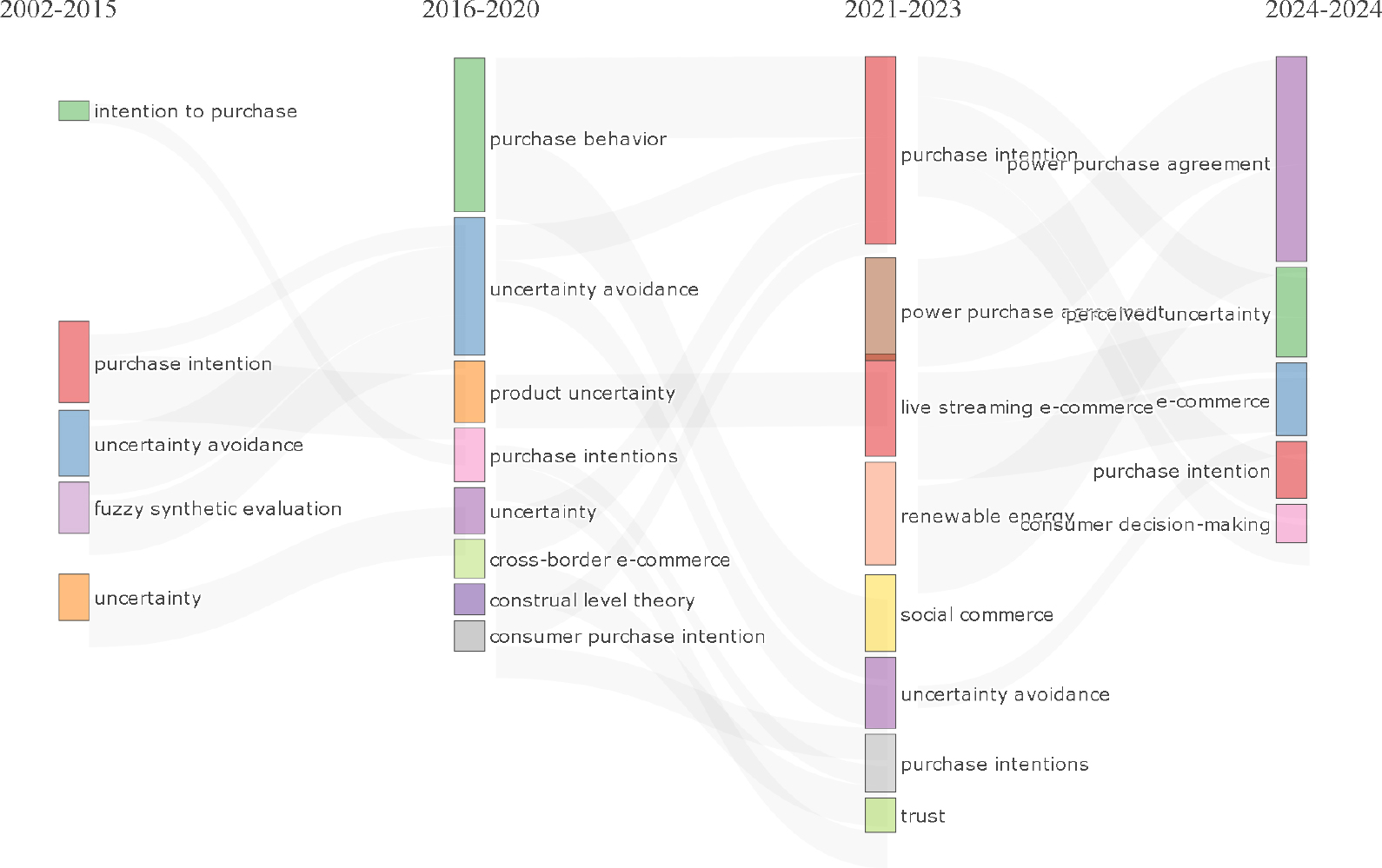
Figure 8:
Thematic Evolution.
In the first period (2002-2015), themes such as intention to purchase, purchase intention, uncertainty avoidance, fuzzy synthetic evaluation, and uncertainty dominated. These themes reflect the research’s initial focus on factors influencing consumer behavior through the perception of uncertainty.
In the second period (2016-2020), uncertainty remained a significant theme but is now connected to new themes such as cross-border e-commerce and product uncertainty. This finding shows that research attention is shifting to the problem of uncertainty that may arise in the online shopping process.
The emergence of “e-commerce live streaming” as a research theme reflects the shifting consumer landscape where interactive, real-time purchasing experiences are reducing perceived uncertainty. Live streaming enables direct interaction between consumers and sellers, providing immediate product demonstrations and addressing consumer inquiries in real time. This trend highlights the growing importance of real-time engagement and trust-building mechanisms in digital commerce, paving the way for further research on its impact on purchase intention.
In the third period (2021-2022), new themes such as social commerce and trust emerged. These themes indicate a greater interest in understanding how perceived uncertainty and value affect consumer purchasing decisions. Finally, in the last projected period (2023-2024), some previous themes, such as uncertainty, remained, but new expectations emerged, with terms such as uncertainty avoidance evolving into perceived uncertainty aunty. This theme shows the progress of research towards predicting perceived uncertainty and future purchase intentions.
Intellectual Structure
Co-Citation Network
Biblioshiny’s co-citation network, presented in Figure 9, provides in-depth information about the relationships between the various authors in the research literature. The nodes (circles) in this graph represent the authors, with the node size reflecting the frequency of co-citation; larger nodes indicate that the author is frequently cited along with other authors. The line connecting the nodes indicates that the two authors have been cited together in another work, and the thickness of the line indicates the strength of the relationship.
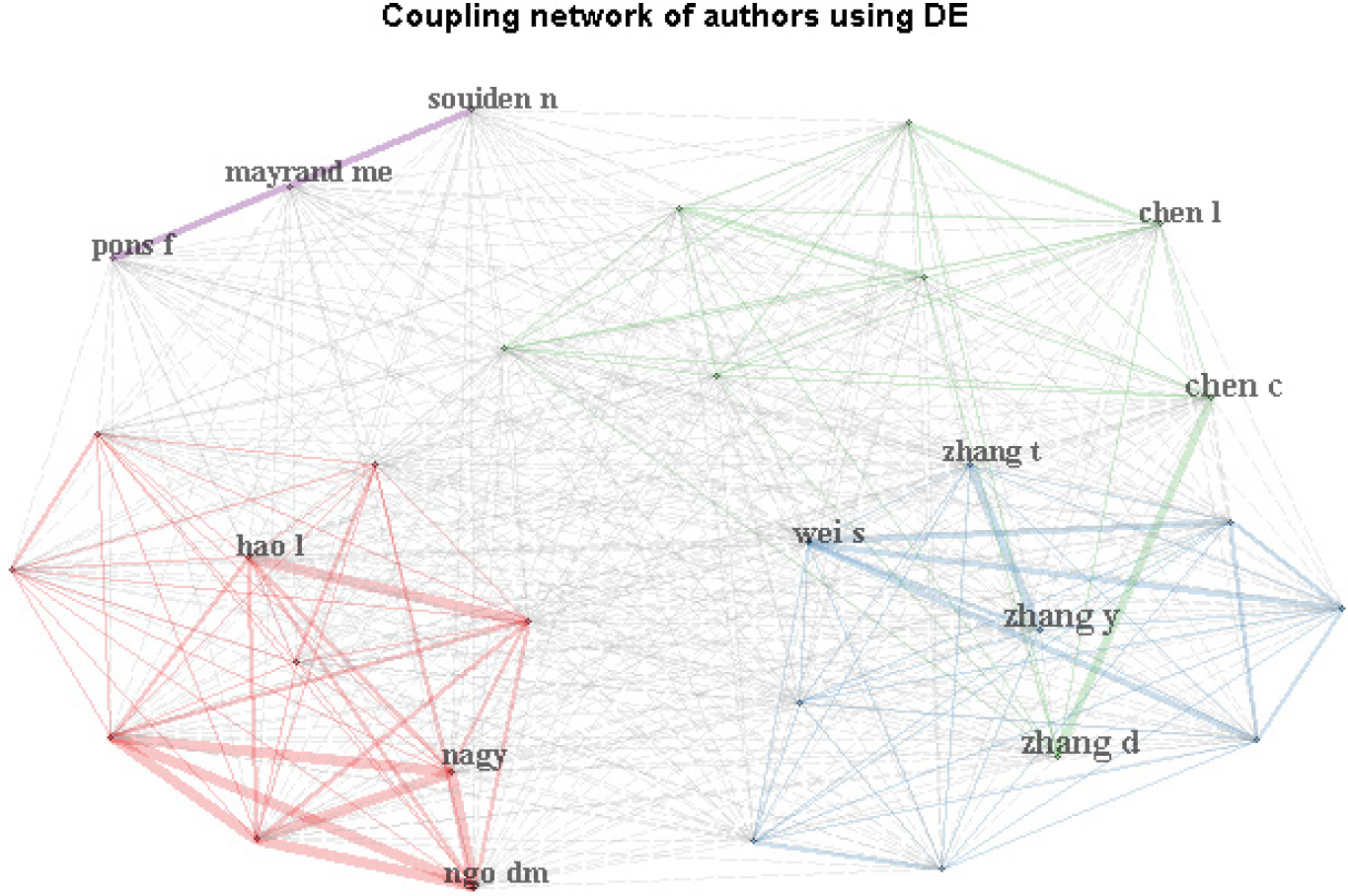
Figure 9:
Co-citation network.
Author Zhang Y stands out in the middle of the graph with a large node size, indicating that this author is often cited along with other authors in this work. Around Zhang y are other writers such as Zhang t, Zhang d, Wei S, and Chen c, each of which is connected to Zhang y and each other to varying grees. This structure shows that Zhang Y is a central figure in the field of research on the relationship between perceived uncertainty and purchase intention, with many collaborations or influences in the literature.
Social Structure
Authors Collaboration Map
Figure 10 shows the collaborative relationship between various authors in research on perceived uncertainty and purchase intention. Each node labeled with the author’s name represents an individual researcher, while the lines connecting them indicate a collaborative relationship. The size of each node correlates with the level of collaboration or the number of publications, with Chen Y looking very central and more significant than the others,
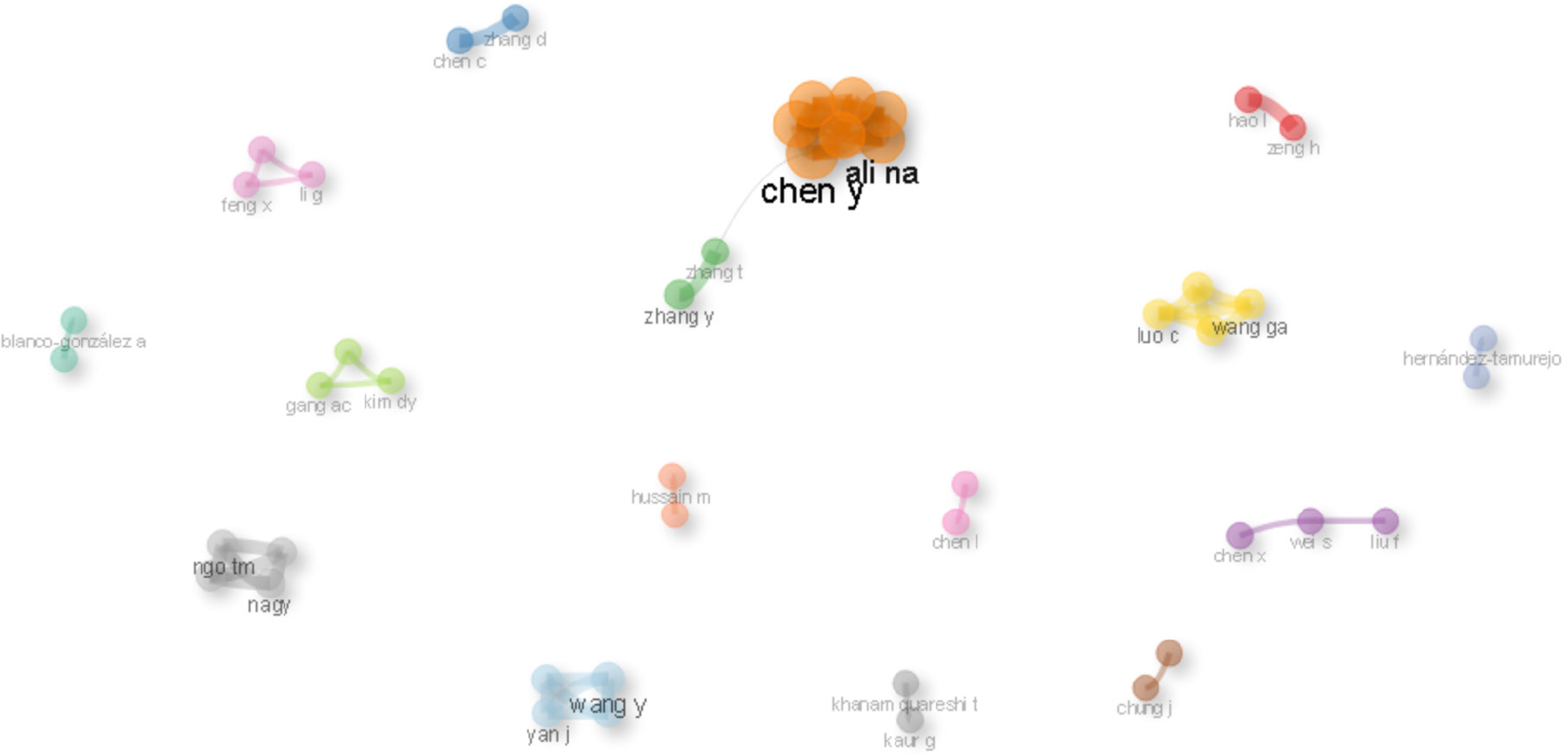
Figure 10:
Authors Collaboration Map.
In addition to Chen Y, other authors seen in this map include Ali Na, Zhang Y, Wang Y, and others. Different colors on the nodes indicate different groups or clusters within the research community that tend to collaborate more closely with each other. The map visually depicts the collaborative landscape in the field of research on perceived uncertainty and purchase intention, highlighting key researchers and showing how knowledge is built collectively through partnerships among researchers.
Country Collaboration Map
The country collaboration map shown in Figure 11 provides information about international collaboration in research regarding the relationship between perceived uncertainty and purchase in the nation. The map uses various shades of blue to indicate the level of collaboration between countries, with darker shades indicating stronger or more frequent collaboration. The lines connecting different countries indicate a partnership or joint research effort.
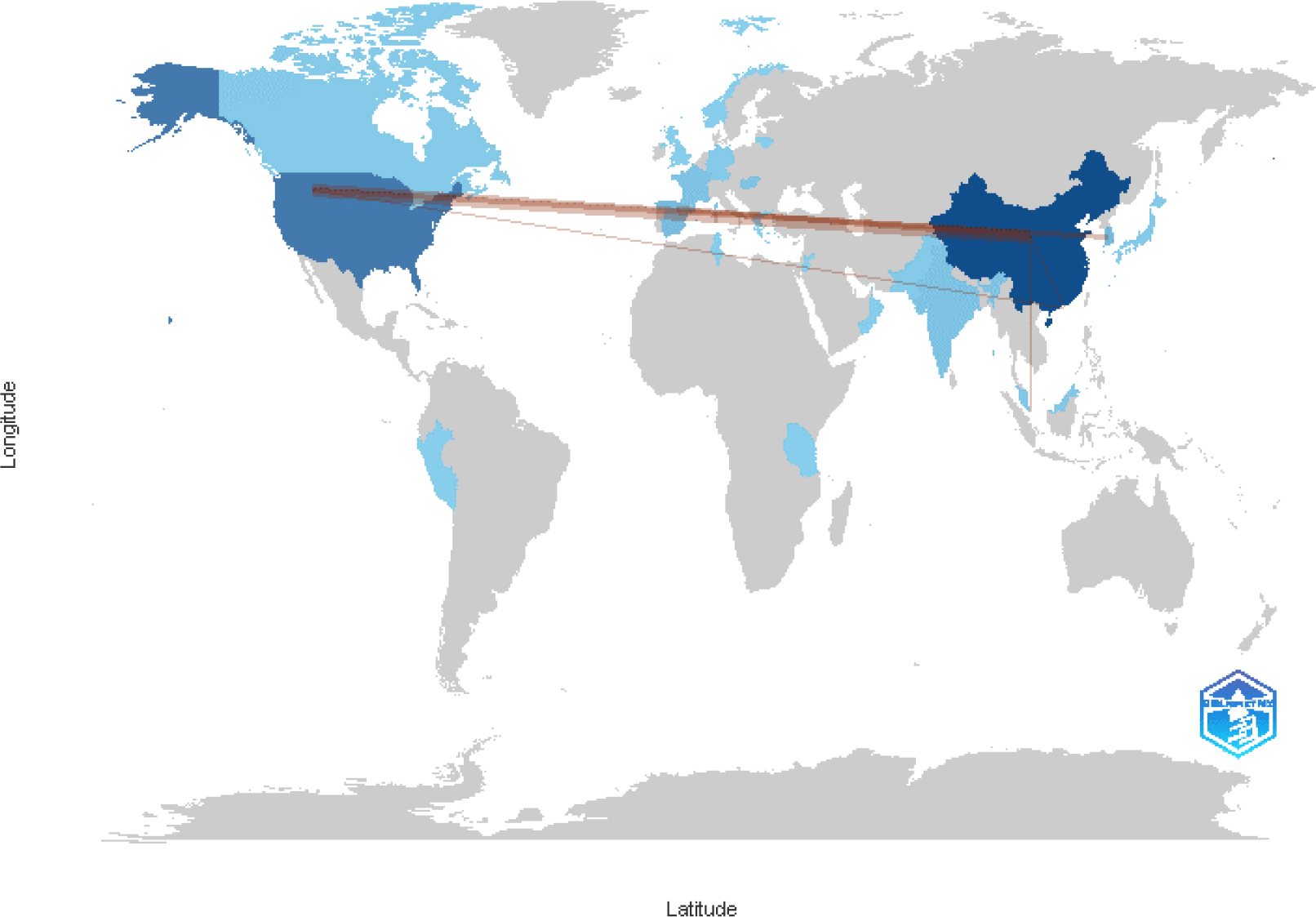
Figure 11:
Country Collaboration Map.
Countries such as the United States and China collaborate extensively in this research. The lines linking these countries show that they often collaborate in studies related to perceived uncertainty and purchase in the nation. Other countries participating in collaborative research are Korea, Vietnam, and Si. This collaboration showed that research on the relationship between perceived uncertainty and purchase intent is a topic of global interest and involves many countries in joint research efforts.
Beyond the dominant roles of the United States and China, Korea and Germany have made notable contributions to this field. Korean research often emphasizes digital consumer behavior, fintech applications, and AI-driven solutions for uncertainty reduction. German scholars, on the other hand, focus on trust-building mechanisms, regulatory frameworks, and ethical considerations in mitigating uncertainty. These unique contributions enrich the global discourse on uncertainty management and consumer decision-making.
Network, Overlay, and Density Visualization
Vos Viewer was used to see the relationship between variables, temporal dynamics of variables that appear in the dataset, and variables that are most often discussed in the analyzed articles. It is presented in the form of network visualization, overlay visualization, and density visualization, which are presented in Figures 12–14.
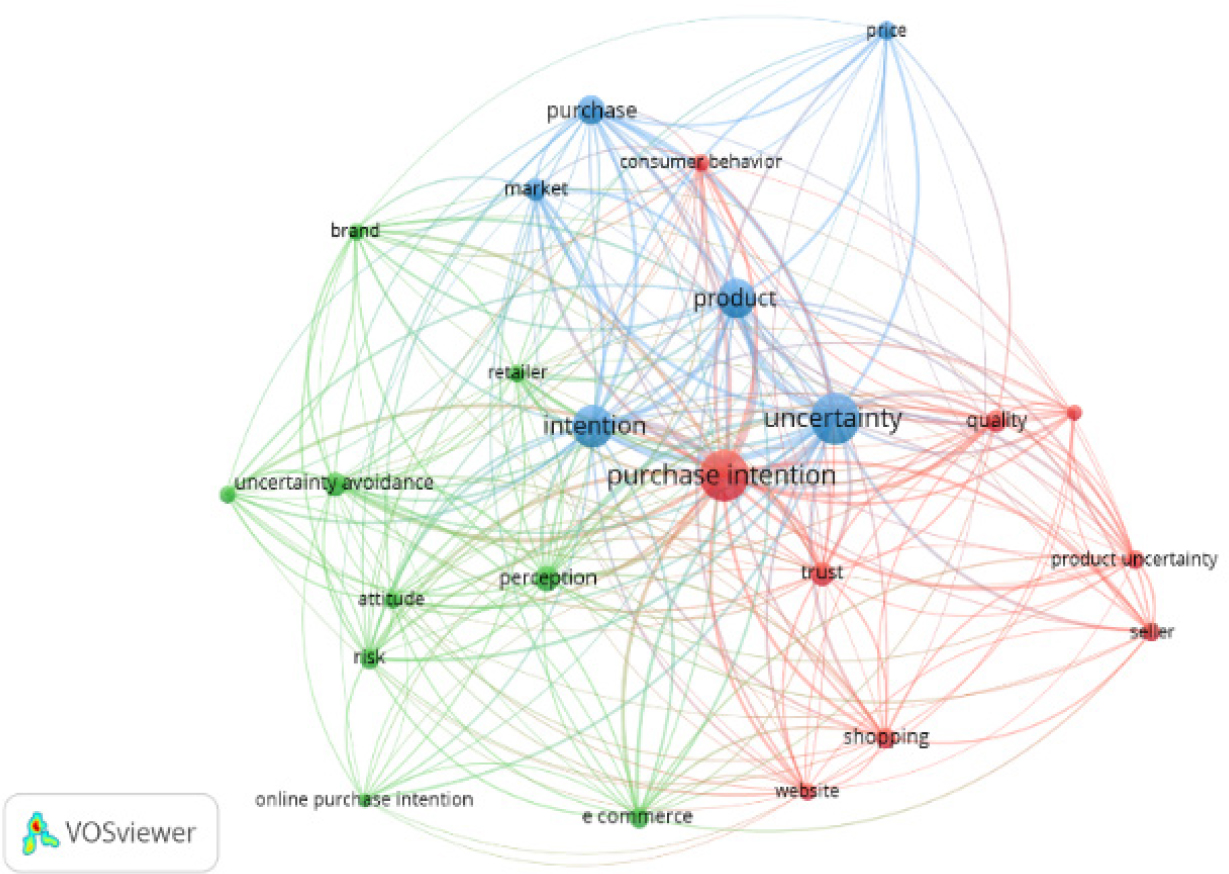
Figure 12:
Network Visualization.
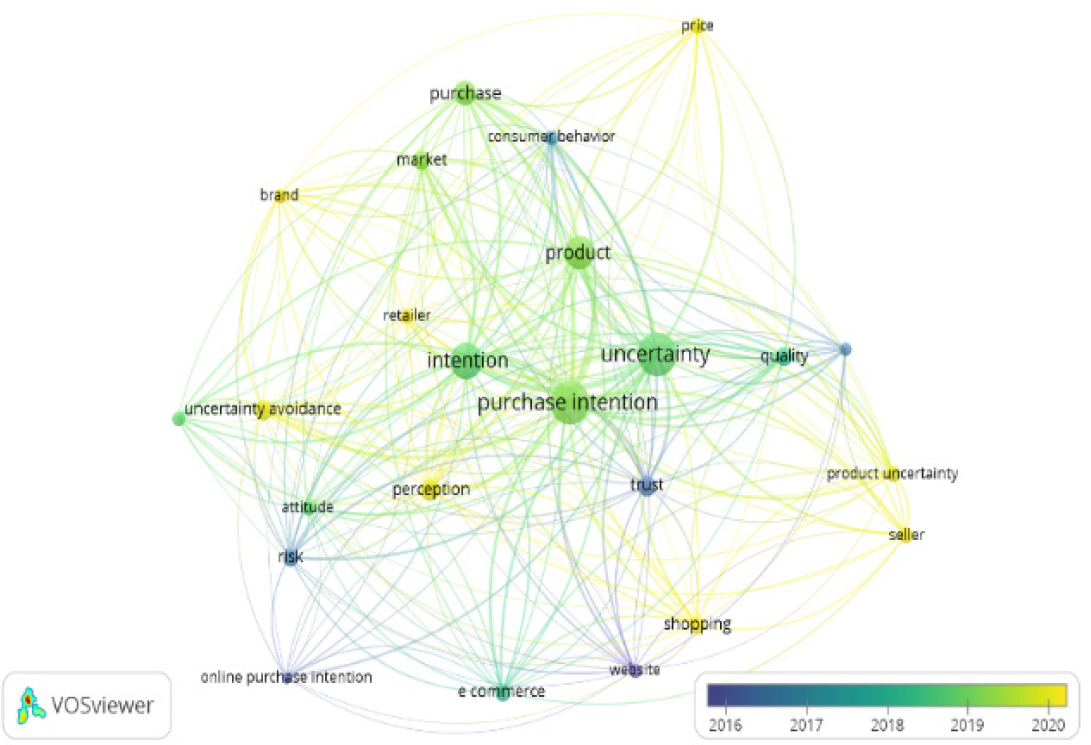
Figure 13:
Overlay Visualization.
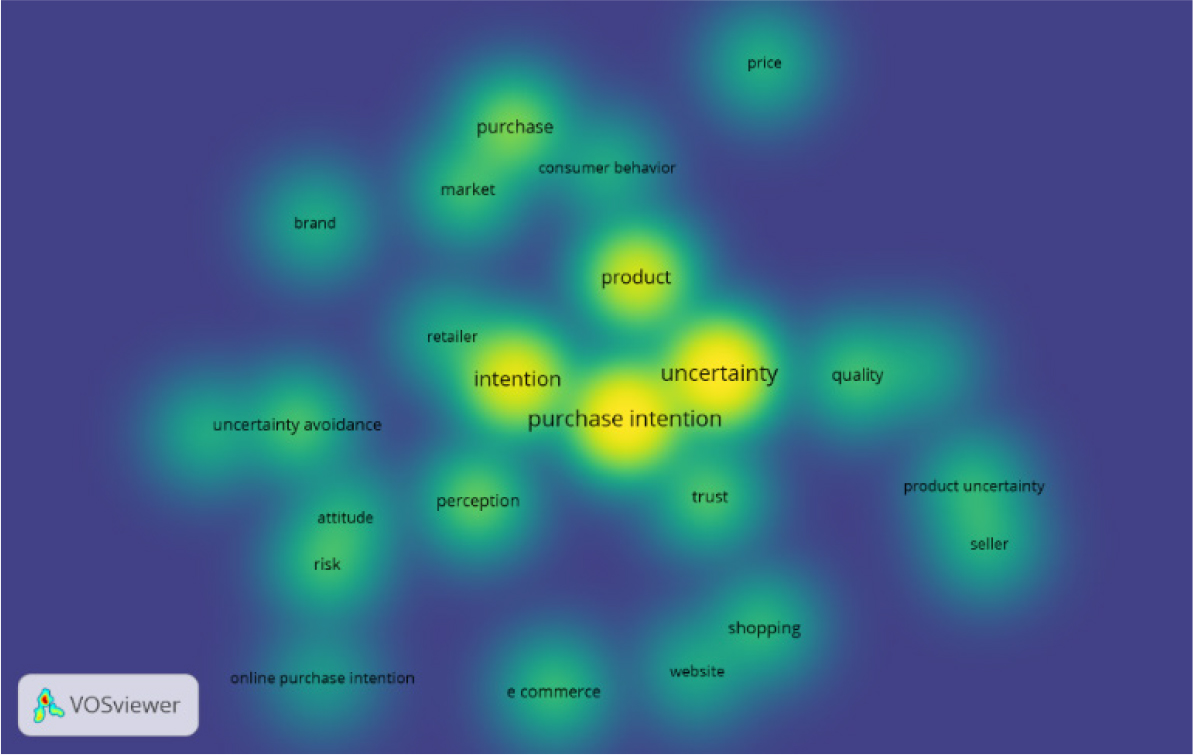
Figure 14:
Density Visualization.
Theories
The theories used in the analyzed articles are presented in the following Table 8.
| Sl. No. | Theory | Number Of Publication | No | Theory | Number of Publication |
|---|---|---|---|---|---|
| 1 | Uncertainty Reduction Theory | 11 | 14 | Integration of Uncertainty Reduction Theory and Social Influence Theory | 1 |
| 2 | Integration of Consumer Behavior Theory and Uncertainty Theory | 9 | 15 | Integration of Uncertainty Reduction Theory and Signalling Theory | 1 |
| 3 | Integration Of Uncertainty Theory and Game Theory | 8 | 16 | Integration of Uncertainty Reduction Theory and TPB | 1 |
| 4 | Decision-Making Under Uncertainty Theory | 7 | 17 | Integration of Uncertainty Reduction Theory and Belief Function Theory | 1 |
| 5 | Theory of Planned Behavior (TPB) | 6 | 18 | Integration of Uncertainty Theory and Consumer Attitude and Behavior Theory | 1 |
| 6 | Uncertainty Theory | 6 | 19 | Market Uncertainty Theory | 1 |
| 7 | Hofstede’s Cultural Dimensions Theory | 3 | 20 | Cross-Cultural Theory | 1 |
| 8 | Integration of Uncertainty Theory and Stimulus-Organism-Response (SOR) Model | 3 | 21 | Cue Utilization Theory | 1 |
| 9 | Integration Of Uncertainty Theory and Supply Chain Management Theory | 3 | 22 | Demand Uncertainty Theory | 1 |
| 10 | Integration of Uncertainty Reduction Theory and Technology Acceptance Model (TAM) | 3 | 23 | Herd Behavior Theory | 1 |
| 11 | Integration of Uncertainty Theory and Cultural Theory | 2 | 24 | Imitation Theory | 1 |
| 12 | Integration Of Uncertainty Theory and Dynamic Pricing Theory | 1 | 25 | Information Asymmetry Theory | 1 |
| 13 | Integration of Uncertainty Theory and Prospect Theory | 1 | 26 | Others Theory | 16 |
DISCUSSION
Performance Analysis
The findings from the literature performance analysis on the relationship between perceived uncertainty and purchase intention which includes data from 2002 to 2024 have broad and profound implications for the development of the body of knowledge in this field The annual growth rate of the document which reached 11.57% shows that the topic of the relationship between perceived uncertainty and purchase intention is a rapidly growing research area This growth reflects the growing academic interest and relevance of the topic in an ever-changing context, such as technological developments and changing consumer behavior The average age of the document of 4.8 years indicates that this literature is relatively new, so there is great potential for innovation and discoveries that can enrich the body of knowledge The average citations per document which reached 19.92 shows that research in this area has a significant impact The high number of citations indicates that these works are often referenced by other researchers, demonstrating their relevance and influence in shaping understanding and theory of perceived uncertainty and purchase intention It also shows that the research conducted is of high quality and makes a meaningful contribution to the literature.
With the increasing number of publications and international collaborations, there is an excellent opportunity to further explore how contextual factors affect the relationship between perceived uncertainty and purchase intention Future research may focus on variables such as cultural differences, technological developments, and global economic changes that can moderate or mediate these relationships Additionally, interdisciplinary research that combines insights from psychology, marketing, and information technology can provide a more comprehensive understanding of the dynamics of these relationships Although research in this area has proliferated, there are still some challenges that need to be addressed One of them is to ensure that the research findings can be applied in a natural context with various influencing variables In addition, more research is needed to explore how new technologies, such as artificial intelligence and big data analytics, can be used to reduce perceived uncertainty and improve purchase intention Other opportunities include exploring the role of social media and e-commerce platforms in shaping consumer perceptions and influencing purchasing decisions.
The findings from this performance analysis show that the relationship between perceived uncertainty and purchase intention is a dynamic and evolving research area. The diversity of sources, the high rate of citations, and international collaborations show that this topic is not only academically relevant but also has far-reaching practical implications. Further research in this area is crucial to deepen our understanding of how to manage perceived uncertainty by consumers and improve purchase intent in an ever-changing context. Thus, this research not only enriches the body of knowledge but also makes a meaningful contribution to business practices and marketing strategies.
Source Analysis Finding
The findings from the bibliometric analysis covering the most relevant sources, source impacts, and distributions based on Bradford’s Law point to some important insights that can enrich the literature and provide guidance for future research First, the diversity of sources that discuss the relationship between perceived uncertainty and purchase intention shows that this topic is relevant in various fields of science The primary sources identified came from conferences and journals in the fields of psychology, marketing, human behavior, and information systems This diversity shows that perceived uncertainty is a multidimensional concept and has broad implications in the context of consumers and organizations For example, in the field of psychology, understanding how perceived uncertainty affects purchase intent can help develop more effective interventions to reduce uncertainty and increase consumer confidence.[1,46–51] On the other hand, in the field of marketing, these insights can help marketers to design better communication strategies to reduce perceived uncertainty by consumers, thereby encouraging purchase intent.[52–55]
Second, these findings also show the importance of sources with high citation impact in directing future research. Journals such as Frontiers in Psychology, International Business Review, International Journal of Environmental Research and Public Health, and Journal of Marketing Management have a significant number of citations, indicating that articles published in these journals are highly influential in the literature. These findings the implication that the studies published in these journals are often used as a reference and foundation for further research, thus enriching the body of knowledge as a whole. Thus, researchers who want to contribute significantly to the literature on perceived uncertainty and purchase intention should consider publishing their findings in these high-impact journals.
Third, the distribution of sources based on Bradford’s Law indicates that a small number of primary sources account for the majority of relevant articles. This distribution has some necessary implications. First, for researchers who are new to the field, focusing on these primary sources can provide a solid foundation for understanding the existing literature. Second, it also shows that although many journals and conferences discuss this topic, only a few have a significant influence in shaping the body of kn ledge. Therefore, efforts to publish research in these primary sources can increase the visibility and overall impact of the research. In addition, the results of this analysis also show several gaps in the literature that can be explored further. Although the topic of perceived uncertainty and purchase intention has been widely discussed, there is still room to explore the contextual factors that can moderate or mediate these relationships.
Document Analysis Finding
The results of this analysis show how research on perceived uncertainty and purchase intent has evolved, with key topics and focus shifting according to new trends and needs in the field of e-commerce and consumer behavior. Terms such as purchase intention, uncertainty, and perceived uncertainty appear with high frequency, suggesting that these themes are the main focus of the study. Words such as e-commerce and cross-border e-commerce are also prominent, signaling that the context of online shopping is an important area where the relationship between uncertainty and purchase intent is explored. The word size in the word cloud reflects the frequency and relevance of the term in the study, indicating that perceived uncertainty is a central theme that is often the focus of the study.
Trends in topics that evolve also show the changes and focus that emerge in research on perceived uncertainty and purchase intent Since 2017, topics such as purchase intent and trust have received consistent attention, signalling early interest in purchase intent and product engagement The topic of uncertainty avoidance shows the highest frequency, with 28 occurrences, indicating stability and relevance until 2023 The topic of uncertainty is the most frequently discussed, reaching its peak between 2014 and 2022, reflecting the continued interest in this topic In recent years, topics such as purchase intentions, purchase behavior, and purchase intention have shown increased interest, especially from 2021 to 2023 Perceived uncertainty and e-commerce are also increasingly discussed, with e-commerce remaining relevant until 2024 Finally, new topics such as e-commerce live streaming have begun to gain significant attention in the past two years, especially in 2023 and 2024, signalling new developments in the field of e-commerce.
Scientific Mapping Finding
The analysis of intellectual structure through co-citation networks and country collaboration maps provides in-depth insights into research dynamics in the field of the relationship between perceived uncertainty and purchase intention. The co-citation network graph shows the complex network of authors who contributed to this literature. Author Chen Y emerged as the center of attention, which shows that he is a writer who is often quoted alongside other thors. Around him, there are writers such as Ali Na, Zhang Y, Wang Y, and others, each of whom has an interconnected relationship with Chen Z and each other in varying grees. This connection shows that Chen Y is a central figure in research on the relationship between perceived uncertainty and purchase intention. This author has a significant influence and often collaborates or becomes a primary reference in the literature, reflecting a central force in this network of knowledge.
The country collaboration map shows the pattern of international collaboration in this study. Countries such as the United States, China, Korea, Vietnam, and Singapore stand out, indicating that they collaborate highly on research on perceived uncertainty and purchase intent. The lines connecting these countries reflect the active partnerships and joint research efforts that often occur between them. The intellectual structure and map of the country’s collaboration provide an overview of how research in this field is distributed and connected globally. Co-citation networks show vital authors and their relationships in the literature, while country collaboration maps illustrate international reach and partnerships in studies of perceived uncertainty and purchase intention.
Network, Density, and Overlay Visualization
In network visualization, there are a number of variables that are interconnected with each other. These variables are represented in the form of nodes, such as “perceived uncertainty,” “purchase intention,” and “consumer behavior.” Variables with larger node sizes indicate a higher frequency of their occurrence in related studies. The line connecting the nodes describes the coexistence relationship between variables, where variables that often appear together, such as “trust” and “risk perception,” have a thick line. With clusters formed based on color, it can be seen that themes such as “brand trust” and “decision-making” are incorporated into separate clusters, reflecting the close relationship between these variables.
An overlay visualization shows the temporal dynamics of the variables that appear in the taste. Newer variables, such as “online shopping” or “digital marketing,” are marked with lighter colors, indicating that these topics are newer and developing in research. Meanwhile, variables such as “customer satisfaction” and “service quality” that appeared earlier are represented by darker hours. This visualization shows that the focus of research has shifted from traditional topics to more modern ones related to digitalization and e-commerce.
In density visualization, the most frequently discussed variables, such as “consumer trust” and “purchase intention,” are seen at a higher density, depicted with light areas. These variables suggest that they are the center of attention in related research. In contrast, variables such as “brand loyalty” and “perceived value” appear with lower density, suggesting that while important, they are not as discussed as much compared to other variables. This visualization helps identify denser research areas and provides an overview of the potential for further research on less explored topics.
Theories
The analyzed articles use the Uncertainty Reduction Theory, which dominates with 11 public cations. This finding suggests that uncertainty plays a vital role in understanding consumer behavior, especially in the context of decision-making under uncertainty.
In addition, several theoretical integrations combine the Uncertainty Reduction Theory with other theories. For example, the integration between Consumer Behaviour Theory and Uncertainty Theory has 9 publications, showing that this combination is widely used to analyze how uncertainty affects consumer behavior in different situations. Integration with Game Theory also appears quite often, with 8 publications, and is usually used to understand the dynamics of strategic interactions in uncertainty-filled decision-making.
Seven publications follow Decision-Making Under Uncertainty Theory, highlighting the importance of decision-making analysis in uncertain situation options. In addition, the Theory of Planned Behavior (TPB) is also widely used, with six publications, often combined with uncertainty theory to predict behavioural intentions in situations full of doubt.
Other theoretical integrations, such as the Technology Acceptance Model (TAM), Hofstede’s Cultural Dimension Theory, and the Stimulus-Organism-Response (SOR) Model, have 3 publications each, suggesting that the cross-theoretical approach is widely used in research involving uncertainty. In addition to the theories that often appear, some theories only appear in one or two publications, such as Information Asymmetry Theory and Herd Behavior Theory, which show a variety of theoretical approaches used to explain the phenomenon of uncertainty.
CONCLUSION
This study aimed to evaluate the relationship between perceived uncertainty and purchase intention through bibliometric analysis. This study used the bibliometric insights and highlighted actionable strategies for businesses to mitigate perceived uncertainty. Leveraging AI-driven recommendation systems, enhancing transparency through blockchain-based verification, and fostering community-driven trust mechanisms are practical approaches to reducing consumer hesitation in digital commerce. These findings offer valuable implications for both academics and practitioners, setting the stage for future interdisciplinary research on uncertainty management in evolving consumer markets.
Synthesizing the findings, this study illustrated the dynamic interplay between perceived uncertainty and purchase intention, reinforced by the evolution of consumer trust mechanisms. The bibliometric trends highlighted the increasing academic and practical relevance of this topic, particularly in digital and cross-border commerce.
The annual publication growth rate of 18.52% indicates an increase in academic interest in the topic, with the average citations per document reaching 19.92, demonstrating a significant impact on the field. Primary sources of literature come from the fields of psychology and marketing, with journals such as Frontiers in Psychology, International Business Review, International Journal of Environmental Research and Public Health, and Journal of Marketing Management playing an essential role. Terms such as perceived uncertainty and purchase intent have been the main focus of recent research efforts.
The findings of the analysis of the document revealed a surge in interest in topics such as purchase intent, purchasing behavior, and perceived uncertainty, especially from 2021 to 2023, indicating a growing research landscape. New topics such as e-commerce live streaming have gained significant attention in recent years, especially in 2023 and 2024, signaling new developments in the e-commerce and purchase intent domains. The heavily cited articles on perceived uncertainty and purchase intent highlight the significant research contribution in this area, demonstrating its impact and relevance.
Topic analysis related to uncertainty shows consistent interest over the years, with perceived uncertainty and purchase intention being frequently discussed topics, reflecting stability and relevance through 2023. Scientific mapping reveals a strong network of international collaborations, with countries such as the United States, China, Korea, Vietnam, and Singapore playing a dominant role, providing essential insights for academics and practitioners in managing uncertainty to increase purchase intent and pave the way for further research into the contextual factors influencing these relationships.
Variables such as “perceived uncertainty”, “purchase intention”, and “consumer behavior” are interrelated in various studies Variables with a high frequency of occurrence, such as “trust” and “risk perception”, have a close relationship, as seen from the thicker lines in the network visualization The overlay visualization showed that the focus of research has shifted from traditional topics, such as “customer satisfaction” and “service quality”, to more modern issues, such as “online shopping” and “digital marketing” In density visualization, “consumer trust” and “purchase intention” are in the center of attention, while topics such as “brand loyalty” are less frequently discussed From a theoretical perspective, Uncertainty Reduction Theory dominates, followed by the integration of other theories such as Game Theory and Theory of Planned Behavior This cross-theoretical combination suggests a more holistic approach to understanding how uncertainty affects consumer behavior In addition, theories such as Information Asymmetry Theory and Herd Behavior Theory, although rarely used, add variety in explaining consumer uncertainty This study identified the potential for further exploration in an area that is less discussed.
Cite this article:
Zulfikar R, Hussein AS, Suryadi N, Margono. Perceived Uncertainty and its Connection to Purchase Intention: Mapping Research. J Scientometric Res. 2025;14(2):672-694.
RESEARCH IMPLICATIONS
The theoretical implications of this study suggest that the relationship between perceived uncertainty and purchase intention has a strong basis in various theories of consumer behavior and decision-making under uncertainty The use of theories such as Uncertainty Reduction Theory, Theory of Planned Behavior (TPB), and Game Theory, as well as their integration with other theories, enriches a theoretical understanding of how uncertainty affects consumer decision-making processes These findings reinforce the concept that uncertainty is an essential factor to consider in models of consumer behavior, especially in situations involving new technologies and global economic changes The research also makes a significant contribution to the literature by suggesting the need for a multidisciplinary approach to understanding the dynamics of uncertainty and purchase intent, as well as encouraging further research that incorporates insights from different fields, such as psychology, marketing, and information technology.
The practical implications of these findings are very relevant for businesses, marketers, and e-commerce platform developers. Understanding how uncertainty can affect consumer purchase intent allows companies to design strategies that are more effective in reducing that uncertainty, For example, by increasing consumer trust through information transparency, strengthening brand image, and leveraging new technologies such as artificial intelligence to provide a more personalized and secure shopping experience Additionally, the importance of factors such as trust, risk perception, and product value in moderating the relationship between uncertainty and purchase intent provides essential insights for marketers in developing communication and marketing strategies As such, companies can be more responsive to changing consumer behavior and market dynamics, especially in the ever-evolving digital era.
RESEARCH LIMITATIONS
The limitation of this study lies in the scope of the data, which only includes articles from the Scopus database, so the results of the study may only reflect part of the literature in this field. In addition, the analysis used, namely bibliometrics, is quantitative and does not explore in depth the qualitative or interpretive aspects of the relationship between perceived uncertainty and purchase intention.
Integrating qualitative methodologies, such as thematic content analysis of consumer discourse on uncertainty, could offer deeper insights into the psychological mechanisms underlying purchase intention. Future studies should adopt a mixed-method approach to enrich the findings and address the contextual nuances of uncertainty in different market environments.
Another limitation is also related to the reliance on citation frequency as a measure of impact, which may not necessarily reflect the long-term quality or relevance of the study. This study also does not highlight in-depth contextual factors such as cultural differences or the influence of technological developments that can moderate these relationships.
References
- Al-Thaqeb SA, Algharabali BG.. Economic policy uncertainty: A literature review.. J Econ Asymmetries.. 2019:20 [CrossRef] | [Google Scholar]
- Aria M, Cuccurullo C.. bibliometrix: an R-tool for comprehensive science mapping analysis.. J Inf.. 2017;11(4):959-75. [CrossRef] | [Google Scholar]
- Armawan I., Hermawan A, Patmi rahayu W.. The Application SOR Theory in Social Media Marketing and Brand of Purchase Intention in Indonesia: Systematic Literature Review. J Posit Sch Psychol.. 2022a.;2022(10) [CrossRef] | [Google Scholar]
- Armawan I., Hermawan A, Patmi rahayu W.. The Application SOR Theory in Social Media Marketing and Brand of Purchase Intention in Indonesia: Systematic Literature Review. J Posit Sch Psychol.. 2022b.;2022(10) [CrossRef] | [Google Scholar]
- Bevan LD.. The ambiguities of uncertainty: a review of uncertainty frameworks relevant to the assessment of environmental change.. Futures.. 2022:137 [CrossRef] | [Google Scholar]
- Bulsara HP, Vaghela PS.. Trust and online purchase intention: a systematic literature review through meta-analysis.. Int J Electron Bus.. 2023;18(2) [CrossRef] | [Google Scholar]
- Byé MF, Carter CF, Meredith GP, Schackle GL, Bye MF.. Uncertainty and business decisions. The logic, philosophy and psychology of business decision-making under uncertainty.. A Symposium. Rev Econ.. 1961;12(1) [CrossRef] | [Google Scholar]
- Chen C, Zhang D.. Understanding consumers’ live-streaming shopping from a benefit-risk perspective.. J Serv Mark.. 2023;37(8):973-88. [CrossRef] | [Google Scholar]
- Chen J, Lobo A.. Organic food products in China: determinants of consumers’ purchase intentions.. Int Rev Retail Distrib Con Res.. 2012;22(3):293-314. [CrossRef] | [Google Scholar]
- Chen L, Chen G, Wang S, Jiang L.. The effect of perfectionism on consumers’ intentions to purchase imperfect products.. Behav Sci (Basel).. 2023;13(3):269 [PubMed] | [CrossRef] | [Google Scholar]
- Chen L, Mu H, Ma K, Jiang L.. The effect of lucky price end numbers on consumers’ intention to purchase a product.. Soc Behav Pers.. 2022;50(3):1-18. [CrossRef] | [Google Scholar]
- Choudhri AF, Siddiqui A, Khan NR, Cohen HL.. Understanding bibliometric parameters and analysis.. RadioGraphics.. 2015;35(3):736-46. [PubMed] | [CrossRef] | [Google Scholar]
- Chuah SH, El-Manstrly D, Tseng ML, Ramayah T.. Sustaining customer engagement behavior through corporate social responsibility: the roles of environmental concern and green trust.. J Cleaner Prod.. 2020:262 [CrossRef] | [Google Scholar]
- Cottam ML.. The decision making literature in international relations: a review of the literature and new directions. In: Foreign policy decision making.. 2019:5-31. [CrossRef] | [Google Scholar]
- Davidson G, Kelly B, Macdonald G, Rizzo M, Lombard L, Abogunrin O, et al. Supported decision making: a review of the international literature.. Int J Law Psychiatry.. 2015;38:61-7. [PubMed] | [CrossRef] | [Google Scholar]
- Donthu N, Kumar S, Mukherjee D, Pandey N, Lim WM.. How to conduct a bibliometric analysis: an overview and guidelines.. J Bus Res.. 2021;133:285-96. [CrossRef] | [Google Scholar]
- Dos Reis Neto JF, Kazama AS, Pereira SR.. Determinants of the theory of planned behavior of consumer related to intention to purchase of organic vegetables.. Biosci J.. 2019;35(2) [CrossRef] | [Google Scholar]
- Frank CC, Seaman KL.. Aging, uncertainty, and decision making-A review. Cogn Affect Behav Neurosci.. 2023;23(3):773-87. [PubMed] | [CrossRef] | [Google Scholar]
- Gustafson A, Rice RE.. A review of the effects of uncertainty in public science communication.. Public Underst Sci.. 2020;29(6):614-33. [PubMed] | [CrossRef] | [Google Scholar]
- Hill JM.. Book review: uncertainty and business decisions.. Hum Relat.. 1955;8(1):88-9. [CrossRef] | [Google Scholar]
- Hsin Chang H, Hong Wong K, Sheng Chiu W.. The effects of business systems leveraging on supply chain performance: process innovation and uncertainty as moderators.. Inf Manag.. 2019;56(6) [CrossRef] | [Google Scholar]
- Islam T, Hussain M.. How consumer uncertainty intervene country of origin image and consumer purchase intention? The moderating role of brand image.. Int J Emerg Markets.. 2023;18(11):5049-67. [CrossRef] | [Google Scholar]
- Ivanova G, Moreira AC.. Antecedents of electric vehicle purchase intention from the consumer’s perspective: A systematic literature review.. Sustainability.. 2023;15(4) [CrossRef] | [Google Scholar]
- S K, Gowda KR, Banerjee J.. Click and collect retailing: A study on its influence on the purchase intention of customers.. Trans Mkt J.. 2021;9(2):239-51. [CrossRef] | [Google Scholar]
- Kim D, Nayakankuppam D.. When to present an extended warranty: pre- vs. post-purchasing a product.. Psychol Mark.. 2023;40(9):1821-9. [CrossRef] | [Google Scholar]
- Leong YR, Tajudeen FP, Yeong WC.. Bibliometric and content analysis of the internet of things research: a social science perspective.. Online Inf Rev.. 2021;45(6):1148-66. [CrossRef] | [Google Scholar]
- Li H, Yang Y.. Optimal keywords grouping in sponsored search advertising under uncertain environments.. Int J Electron Com.. 2020;24(1):107-29. [CrossRef] | [Google Scholar]
- Limbu YB, Ahamed AF.. What influences green cosmetics purchase intention and behavior? A systematic review and future research agenda.. Sustainability.. 2023;15(15) [CrossRef] | [Google Scholar]
- Merigó JM, Gil-Lafuente AM, Yager RR.. An overview of fuzzy research with bibliometric indicators.. Appl Soft Comput J.. 2015;27:420-33. [CrossRef] | [Google Scholar]
- Moslehpour M, Ismail T, Purba B, Wong WK.. What makes go-jek go in indonesia? The influences of social media marketing activities on purchase intention.. J Theor Appl Electron Com Res.. 2021;17(1):89-103. [CrossRef] | [Google Scholar]
- Page MJ, McKenzie JE, Bossuyt PM, Boutron I, Hoffmann TC, Mulrow CD, et al. The PRISMA 2020 statement: an updated guideline for reporting systematic reviews.. BMJ.. 2021;372:n71 [PubMed] | [CrossRef] | [Google Scholar]
- Pandey PK, Bajpai N, Tiwari AV.. Factors affecting attitude and purchase intention towards cause-related marketing: a systematic literature review using TCCM approach.. Int Rev Public Nonprofit Mark.. 2024;21(2):479-509. [CrossRef] | [Google Scholar]
- Paramita AS.. Social commerce purchase intention factors in developing countries: a systematic literature review.. J Appl Eng Technol Sci.. 2023;4(2):847-54. [CrossRef] | [Google Scholar]
- Pavlou PA, Liang L, Xue X.. Understanding and mitigating uncertainty in online exchange relationships: A principal-agent perspective.. MIS Q Manag Inf Syst.. 2007;31(1) [CrossRef] | [Google Scholar]
- Sadad Mahmud M, Shah Nawaz M, Jamal A, Sabir I, Bilal Majid M, Mahmood H., et al. Purchase of halal products and consumer behavioral intentions: A systematic literature review.. Int J Disaster Recov Bus Continuity.. 2020;11(3) [CrossRef] | [Google Scholar]
- Salancik GR, Pfeffer J.. Uncertainty, secrecy, and the choice of similar others.. Soc Psychol.. 1978;41(3) [CrossRef] | [Google Scholar]
- Shiu EM, Walsh G, Hassan LM, Shaw D.. Consumer uncertainty, revisited.. Psychol Mark.. 2011;28(6):584-607. [CrossRef] | [Google Scholar]
- Sniazhko S.. Uncertainty in decision-making: a review of the international business literature.. Cogent Bus Manag.. 2019;6(1) [CrossRef] | [Google Scholar]
- Sohaib O, Kang K, Miliszewska I.. Uncertainty avoidance and consumer cognitive innovativeness in e-commerce.. J Glob Inf Manag.. 2019;27(2):59-77. [CrossRef] | [Google Scholar]
- Thi VA, Nagy Á, Ngo TM, Ngo DM.. A cross-culture analysis of risk perception and purchase intention in Vietnamese and Hungarian e-commerce.. Asian J Bus Res.. 2023;13(3):114-39. [CrossRef] | [Google Scholar]
- Venkatesh V, Thong JY, Chan FK, Hu PJ.. Managing citizens’ uncertainty in e-government services: the mediating and moderating roles of transparency and trust.. Inf Syst Res.. 2016;27(1):87-111. [CrossRef] | [Google Scholar]
- Vuong BN, Khanh Giao HN.. The impact of perceived brand Globalness on consumers’ purchase intention and the moderating role of consumer ethnocentrism: an evidence from Vietnam.. J Int Con Mark.. 2020;32(1):47-68. [CrossRef] | [Google Scholar]
- Wang CY, Lee HC, Wu LW, Liu CC.. Quality dimensions in online communities influence purchase intentions.. Manag Decis.. 2017;55(9):1984-98. [CrossRef] | [Google Scholar]
- Wang H, Ma B, Bai R.. How does green product knowledge effectively promote green purchase intention?. Sustainability.. 2019;11(4):1193 [CrossRef] | [Google Scholar]
- Wang J, Shahzad F, Ahmad Z, Abdullah M, Hassan NM.. Trust and consumers’ purchase intention in a social commerce platform: A meta-analytic approach.. Sage Open.. 2022;12(2) [CrossRef] | [Google Scholar]
- Wei S, Liu F, She S, Wu R.. Values, motives, and organic food consumption in China: A moderating role of perceived uncertainty.. Front Psychol.. 2022;13:736168 [PubMed] | [CrossRef] | [Google Scholar]
- Wickens CD, Smith C, Clegg B, Herdener N.. Proceedings of the Human Factors and Ergonomics Society Annual Meeting.. 2019;63(1):1394-8. [CrossRef] | [Google Scholar]
- Xu P, Cui BJ, Lyu B.. Influence of Streamer’s social capital on purchase intention in live streaming e-commerce.. Front Psychol.. 2021;12:748172 [PubMed] | [CrossRef] | [Google Scholar]
- Yang H, Song H, Ding QS, Wang H.. Transparency, authenticity and purchase intentions: Chinese independent restaurants.. Int J Contemp Hosp Manag.. 2022;34(11):4245-65. [CrossRef] | [Google Scholar]
- Yoo SH, Ozer M, Xu J.. Relative effects of the different bundles of web-design features on intentions to purchase experience products online.. Decis Support Syst.. 2024:179 [CrossRef] | [Google Scholar]
- Zhang M, Qin F, Wang GA, Luo C.. The impact of live video streaming on online purchase intention.. Serv Ind J.. 2020;40(9-10):656-81. [CrossRef] | [Google Scholar]
- Zhang Y, Zhang T.. The effect of blind box product uncertainty on consumers’ purchase intention: the mediating role of perceived value and the moderating role of purchase intention.. Front Psychol.. 2022;13:946527 [PubMed] | [CrossRef] | [Google Scholar]
- Zhang Y, Zhou H, Qin J.. Research on the effect of uncertain rewards on impulsive purchase intention of blind box products.. Front Behav Neurosci.. 2022;16:946337 [PubMed] | [CrossRef] | [Google Scholar]
- Zhao L, Lee SH, Copeland LR.. Social media and Chinese consumers’ environmentally sustainable apparel purchase intentions.. Asia Pac J Mark Logist.. 2019;31(4):855-74. [CrossRef] | [Google Scholar]
- Zhao L, Peng J, Yu S.. Sustainable luxury and consumer purchase intention: A systematic literature review.. Sage Open.. 2023;13(4) [CrossRef] | [Google Scholar]

